Savez-vous si vous êtes un communicateur soumis, agressif, passif-agressif, manipulateur ou assertif ? Votre style de communication est-il indirect, direct, contrôlant ou soutenant ?
Il ne suffit pas de connaître ces divisions pour aider les gens à identifier leur style de communication. Les définitions, bien que similaires, peuvent varier. Il est donc nécessaire de consacrer à chaque style de communication l'attention qu'il mérite.
Dans ce guide, nous nous pencherons sur la question, “Quels sont les styles de communication auxquels les gens ont généralement recours ??” et nous fournirons une image plus claire à l'aide d'exemples pratiques des styles de communication que nous abordons.
Nous discuterons des avantages et des inconvénients de chaque style et nous expliquerons comment utiliser ces connaissances pour mieux comprendre les autres et mieux communiquer avec eux. Ces informations peuvent également aider les autres à apprendre à mieux communiquer avec vous.

- Les styles de communication sont des façons différentes d'aborder le processus de communication.
- Ils servent à vous apprendre à prendre conscience de vous-même et à optimiser votre approche de la communication.
- Les styles de communication sont classés en fonction de la façon dont l'individu préfère exprimer ses pensées, ses idées et ses émotions.
- Le psychologue Bourne reconnaît 5 styles de communication différents : soumis, agressif, passif-agressif, manipulateur et assertif.
- Alessandra et Hunsaker reconnaissent 4 types de styles de communication — les relationnistes, les socialisateurs, les penseurs et les dirigeants — basés sur 2 dimensions : direct vs. indirect et soutien vs. contrôle.
- Murphy reconnaît 4 styles de communication : analytique, intuitif, fonctionnel et personnel.
- L'auteur et consultant en formation Cox décrit 4 styles de communication : orienté vers l'action, orienté vers le processus, orienté vers les personnes et orienté vers les idées.
- L'auteur Dias, spécialisé dans les affaires, reconnaît 4 styles distincts : le style de communication expressif, le style de communication moteur, le style de communication relationnelle et le style de communication analytique.
Styles de communication : Parvenir à une définition
Les styles de communication sont les différentes façons dont les gens abordent le processus de communication, c'est-à-dire le processus de transmission et d'acceptation d'idées et d'opinions.
Si vous ne comprenez pas votre propre style de communication, il est difficile d'être conscient de vous-même lorsque vous conversez.
Et si vous ne comprenez pas les styles de communication de vos interlocuteurs, il n'est pas facile d'optimiser votre approche de la communication.
Tout comme l'analyse des différents modèles de communication peut nous aider à mieux comprendre les différents aspects d'une situation de communication et à planifier une communication plus réussie, les styles de communication nous permettent d'en savoir plus sur la manière dont les différents styles affectent le processus de communication.
Bien que les gens privilégient généralement un style de communication spécifique, l'apprentissage des divisions ci-dessous peut vous aider à tirer le meilleur parti des différents types.
Voyons comment différents psychologues et auteurs classent les styles de communication.
5 styles de communication de base, répartis par Bourne (1995)
Selon le psychologue Edmund J. Bourne Ph.D. et son livre intitulé Manuel du phobique et de l'anxieux, il existe 5 types différents de styles de communication :
- Soumis,
- Agressif,
- Passif-agressif,
- Manipulateur et
- Assertif.
Pour les individus, ces styles de communication peuvent être dominants ou utilisés dans des situations spécifiques ou avec des personnes spécifiques.
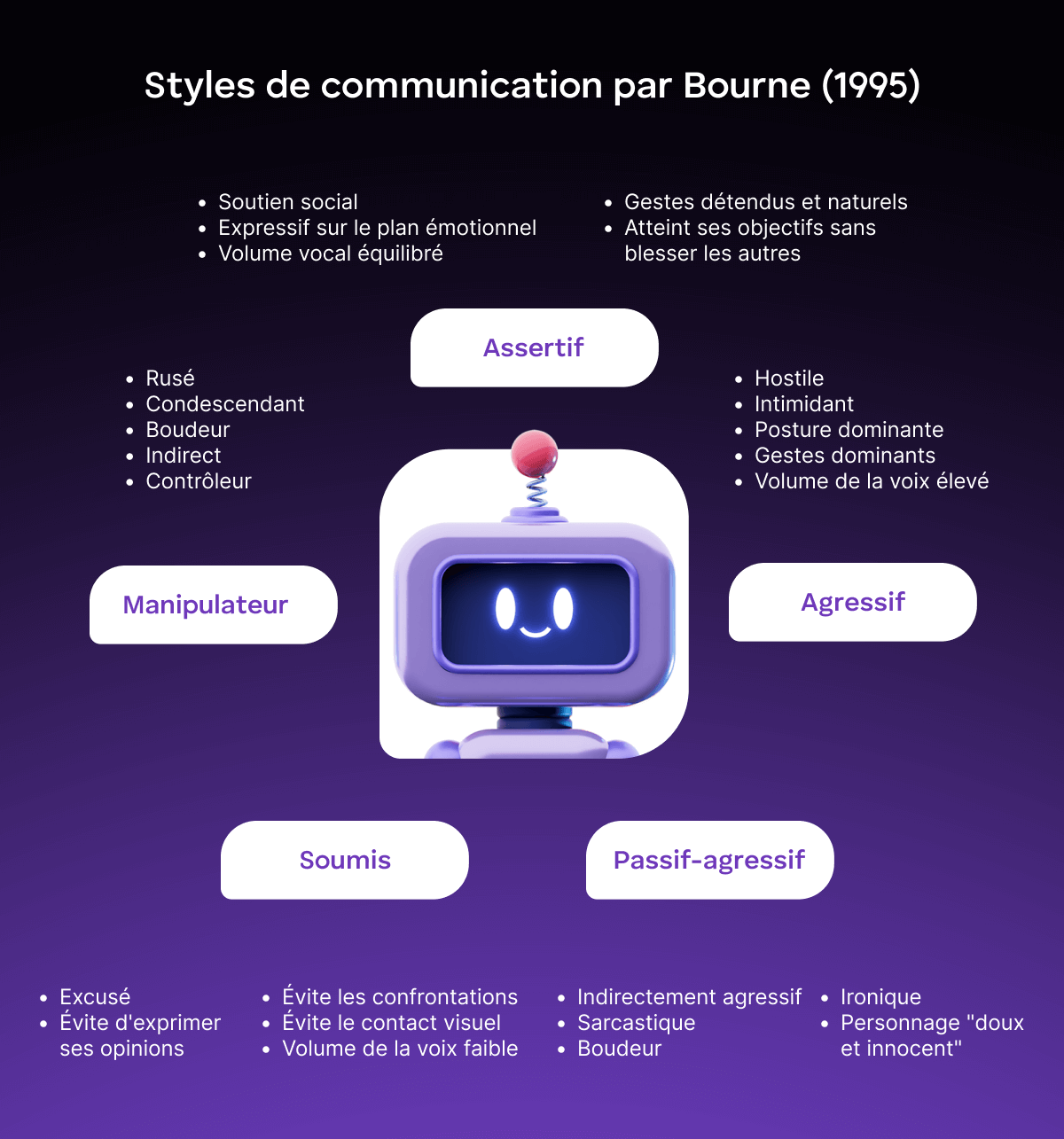
Mais pourquoi est-il important que les professionnels connaissent ces styles de communication ?
La communication sur le lieu de travail est essentielle à la réussite de tout projet. Selon une étude, 86% des employés estiment qu'une mauvaise communication est la première cause d'échec sur le lieu de travail.
La vérité, c'est que personne ne souhaite provoquer des difficultés de communication. Celles-ci surviennent généralement en raison des styles opposés des collègues, ce qui peut entraîner de nombreux problèmes.
Les différences entre ces styles peuvent entraîner une mauvaise communication sur le lieu de travail, ce qui se traduit par des erreurs coûteuses et des délais non respectés. En outre, elles peuvent entraver les flux de travail de l'entreprise, rendant impossible le passage à l'étape suivante et l'achèvement d'un projet.
Les différentes façons dont les employés communiquent peuvent également créer des tensions, de la confusion et du stress sur le lieu de travail parce que les coéquipiers ne comprennent pas les motivations des autres ou interprètent mal les remarques des autres. Dans certains cas, les gens peuvent même se sentir menacés, offensés ou sous-estimés.
À long terme, cela peut avoir un effet négatif sur la fidélisation des employés, les relations avec les clients, les processus internes, les ventes, etc.
Pour qu'une organisation fonctionne de manière optimale, ses équipes doivent surmonter ces différences, comprendre les différents styles de communication et s'efforcer de trouver un terrain d'entente. Après tout, des styles de communication mal adaptés sur le lieu de travail peuvent faire réussir ou échouer une entreprise.
Examinons donc plus en détail ce qu'est chaque style.
🎓 Astuce Pro de Pumble
Comprendre les styles de communication individuels est la première étape pour renforcer la communication au sein de l'équipe. L'étape suivante consiste à se familiariser avec les différents canaux de communication. Consultez notre guide à ce sujet :
n°1 Style de communication soumis (ou style de communication passif)
Le style de communication soumis est axé sur la satisfaction des autres et l'évitement de tout conflit.
Pour les communicateurs soumis, les besoins des autres sont toujours plus importants que leurs propres besoins.
Ils agissent souvent comme si les autres avaient plus de droits qu'eux et plus de moyens de contribuer aux conversations, aux réunions, aux discussions et à d'autres formes de situations de communication.
Les caractéristiques comportementales communes des communicateurs soumis
En ce qui concerne leur comportement général, les communicateurs soumis ont tendance à :
- S'excuser,
- Éviter d'exprimer leurs sentiments, leurs opinions, et leurs désirs,
- Éviter les confrontations,
- Avoir du mal à prendre des responsabilités,
- Avoir des difficultés à prendre des décisions,
- Blâmer les autres pour les événements et les situations,
- Refuser les compliments et
- Se sentir victimes.
Le comportement non verbal courant des communicateurs soumis
En ce qui concerne leur comportement non verbal, les communicateurs soumis ont tendance à :
- Avoir un volume de voix doux,
- Baisser la tête,
- Se tordre et s'agiter,
- Éviter le contact visuel et
- Chercher à occuper le moins d'espace possible pour éviter que les autres ne les remarquent.
🎓 Astuce Pro de Pumble
Le comportement non verbal n'est qu'un des 5 types de communication courants que vous pouvez rencontrer dans un contexte professionnel. Pour en savoir plus sur les différents types de communication, consultez notre guide complet :
Exemples de communication avec des communicateurs soumis
Comme le montrent les exemples ci-dessous, parler à des communicateurs soumis peut être décourageant.
Exemple n°1 : un designer de produits junior et un designer de produits senior discutent de leur dernière solution de conception. Pour éviter de s'engager dans une discussion approfondie susceptible de provoquer un conflit d'opinions, la conceptrice junior met fin à la discussion en disant : “Je vous laisse décider ce qui est le mieux.”
Exemple n°2 : lors d'une réunion de marketing, le directeur du marketing confie une nouvelle série de tâches à une spécialiste de la communication.
Bien que son travail doit doubler au cours de la période à venir, lorsqu'on lui demande si une telle quantité de travail sera trop importante et s'il est préférable de partager les tâches avec le reste de l'équipe de sensibilisation, le spécialiste de la sensibilisation au référencement répond simplement par : “Oh, ce n'est rien, je peux facilement m'en charger.”
Exemple n°3 : un spécialiste de la vente aux entreprises a été promu à un nouveau poste et a reçu un salaire plus élevé qu'un autre spécialiste de la vente aux entreprises qui, objectivement, méritait davantage cette promotion.
Interrogé par ses collègues immédiats, le spécialiste de la vente aux entreprises qui n'a pas été promu répond : “Oh, ce n'est pas grave, je n'en voulais pas de toute façon.”

Chattez avec votre équipe sur Pumble
Ce que ressentent les personnes qui communiquent avec des communicateurs soumis
Les personnes qui communiquent avec des communicateurs soumis sont susceptibles de se sentir :
- Frustrées qu'on leur dise ce qu'elles veulent entendre plutôt que des faits,
- Exaspérées de perdre leur temps dans une communication improductive,
- Réticents à aider le communicateur soumis à améliorer sa communication, car leurs efforts ont tendance à être indirectement rejetés,
- Se sentent coupables de ne pas savoir ce que veut le communicateur soumis,
- Se sentent en position de profiter du communicateur soumis et
- Irritées à l'égard de la faible énergie qui entoure le communicateur soumis.
Conseils pour communiquer avec des communicateurs soumis
Pour tirer le meilleur parti de votre communication avec les communicateurs soumis, vous pouvez jouer le rôle de facilitateur.
Si vous voulez savoir ce que le communicateur soumis pense vraiment, encouragez-le à parler en étant chaleureux, amical et invitant.
Par exemple, lors de réunions de groupe qui impliquent des séances de brainstorming, vous pouvez également encourager les communicateurs soumis à partager en mettant l’accent sur :
“La contribution de chacun est importante et il n'y a pas d'idées stupides, alors n'hésitez pas à partager !”
Comment être moins soumis dans la communication
Bien que vous soyez habitué à un comportement soumis dans la communication et que vous pensiez être poli et respectueux des souhaits de l'autre personne, votre discrétion apparente est en fait à l'origine d'une rupture de la communication.
Si vous voulez devenir un meilleur communicateur, vous devez reconnaître que vous avez un rôle à jouer dans la conversation.
N'ayez pas peur d'exprimer vos opinions et votre désaccord de manière respectueuse. De cette façon, vous serez bénéfique à la fois pour vous et pour votre interlocuteur en favorisant la fluidité de la communication et en évitant l'accumulation de frustrations et de tensions au travail.
Vous pouvez également vous efforcer d'améliorer vos signaux non verbaux :
- En vous entraînant à établir un contact visuel,
- En parlant plus fort et
- En évitant de vous agiter.
Des études ont montré que la façon dont vous utilisez votre langage corporel peut avoirun impact sur vos émotions, vous pouvez donc littéralement faire semblant jusqu'à ce que vous gagniez en confiance.
En cas de désaccord, vous pouvez faire preuve de respect envers l'autre personne en reconnaissant d'abord son point de vue avant d'exprimer vos préoccupations.
Vous pouvez commencer de l'une des manières suivantes :
“Je comprends votre point de vue, mais...”
“Je vois pourquoi vous pensez cela, mais...”
“Votre argument a du sens, mais...”
Vous pouvez toujours adoucir votre présentation par un sourire si vous craignez de passer pour quelqu'un d'arrogant ou d'agressif en exprimant votre opinion.
Bien sûr, vous ne pouvez pas compter sur le langage corporel dans la communication en ligne, mais vous pouvez utiliser des emojis pour montrer que vous avez de bonnes intentions. Heureusement, les applications de communication d'équipe telles que Pumble fournissent des myriades d'emojis pour vous aider à exprimer toute une gamme d'émotions d'une manière conviviale pour le travail.

n°2 Style de communication agressif
Le style de communication agressif vise à gagner à tout prix, ce qui peut souvent se faire aux dépens des autres.
Contrairement aux communicateurs soumis, les communicateurs agressifs accordent plus d'importance à leurs propres besoins qu'à ceux des autres et pensent que leurs opinions sont les plus importantes dans une discussion — et c'est également ainsi qu'ils se comportent.
Ils agissent souvent comme s'ils avaient plus de droits et plus de moyens de contribuer que les autres. En conséquence, l'importance de l'information qu'ils essaient de transmettre peut être éclipsée par la façon inconsidérée dont ils la délivrent.
Les caractéristiques comportementales communes des communicateurs agressifs
En ce qui concerne leur comportement général, les communicateurs agressifs ont tendance à :
- Blâmer les autres,
- Intimider les autres,
- Faire peur,
- Être hostiles,
- Être menaçants,
- Être exigeant,
- Être abrasif,
- Être belliqueux,
- Être explosif,
- Être imprévisible et
- Être intimidant.
Comportement non verbal courant des communicateurs agressifs
En ce qui concerne leur comportement non verbal, les communicateurs agressifs ont tendance à :
- Utiliser un volume de voix élevé pour faire passer leurs idées et leurs opinions,
- Se positionner de manière à paraître plus grands que les autres,
- Utiliser des gestes proéminents, vifs et rapides,
- Se renfrogner, froncer les sourcils ou jeter un regard noir aux autres,
- Envahir l'espace personnel des autres et
- Faire des remarques sarcastiques.
Exemples de communication avec des communicateurs agressifs
Comment ce style de communication peut-il conduire à des ruptures de communication et à une atmosphère inconfortable ? Les exemples ci-dessous peuvent nous donner une idée.
Exemple n°1 : Une discussion sur l'analyse des produits entre deux membres d'une équipe de vente s'envenime lorsque la personne au style de communication agressif s'en prend à son collègue : “Tu es fou ! Ce n'est pas ce que veulent dire les chiffres ! ”
Exemple n°2 : un directeur des ventes fournit un retour d'information au nouveau membre de l'équipe de vente sans beaucoup de tact. Le nouveau spécialiste des ventes s'énerve, ce à quoi le directeur des ventes répond : “Arrêtez de vous plaindre ! Vous me rendez malade !”
Exemple n°3 : une réunion urgente du personnel de l'université sur le lieu du séminaire annuel de formation qui devrait être décidé par vote, mais qui se termine par une déclaration du doyen de l'université qui se lasse rapidement de la discussion : “Ça suffit comme ça ! Nous allons le faire à ma façon !”
Dans ces exemples, les communicateurs agressifs s'adressent à leurs subordonnés. Cela a un impact négatif sur moral et la motivation de l'équipe, ce qui indique que l'agressivité perturbe considérablement la communication sur le lieu de travail, en particulier lorsqu'elle est présente dans les styles de communication des personnes occupant des postes de direction.
🎓Astuce Pro de Pumble
En tant que leader, vous devez connaître le style de communication de vos employés et adapter le vôtre pour que vos employés se sentent compris, en sécurité et valorisés afin qu'ils puissent vraiment briller. Cette tâche est particulièrement ardue si vous dirigez une entreprise à distance. Vous ne savez pas comment y parvenir ? Lisez tous les détails sur notre blog :
Ce que ressentent les personnes qui communiquent avec des communicateurs agressifs
Les personnes qui communiquent avec des communicateurs agressifs sont susceptibles d'éprouver les sentiments suivants :
- Elles ont besoin d'être sur la défensive ou de se retirer de la discussion,
- Elles doivent se montrer agressives en retour et riposter,
- Elles éprouvent du ressentiment et de la vengeance parce qu'elles se sentent blessées, humiliées et même exploitées lorsqu'elles interagissent avec un communicateur agressif,
- Elles ont peur de signaler les erreurs et les problèmes pour éviter d'être blâmés et
- Elles sont généralement moins respectueuses à l'égard d'une personne qui communique de manière agressive.
Conseils pour communiquer avec des communicateurs agressifs
Pour tirer le meilleur parti de votre communication avec des communicateurs agressifs, vous pouvez rechercher activement les interruptions et vous efforcer de les éviter.
Si le communicateur agressif vous interrompt en plein milieu d'une phrase, dites simplement :
“Attendez, je n'ai pas encore fini.”
En plus de cela, vous devez :
- Souligner vos limites,
- Ne jamais répondre de manière agressive et
- Exprimer calmement vos besoins et vos sentiments.
Comment être moins agressif dans la communication
Pour être fructueuse, une conversation doit se dérouler dans les deux sens. Si vous êtes conscient que votre style de communication est trop agressif, vous êtes déjà sur la bonne voie pour devenir un meilleur communicateur.
Il est préférable de commencer par examiner vos tendances agressives et leurs causes.
En attendant, vous pouvez vous efforcer de devenir plus amical, plus accessible et moins menaçant à bien des égards.
Commencez par pratiquer l'écoute active et par reconnaître réellement les idées et les sentiments des autres.
Ensuite, travaillez votre empathie en vous mettant à la place des autres et en prenant un moment de réflexion avant de recourir à un comportement explosif, de blesser ou de rabaisser quelqu'un.
Cependant, il se peut aussi que vous adoptiez un comportement agressif sans même vous en rendre compte, en particulier dans le cadre de la communication en ligne.
Par exemple, le fait de suivre une question non urgente en mentionnant (par exemple @JohnSmith) quelqu'un de manière persistante sur un canal public de Pumble peut être perçu comme ennuyeux et agressif. Il est préférable de limiter votre suivi ou d'envoyer un message direct à la personne.
Vous devez également faire attention à la manière dont vous utilisez le @canal. Par exemple, la notification est-elle si importante qu'il faille envoyer un ping aux membres qui sont actuellement absents ? Si ce n'est pas le cas, vous pouvez utiliser l'option @ici et ne pas déranger les gens pendant leurs pauses ou en dehors des heures de travail.

Un autre type de comportement agressif à éviter est celui qui consiste à faire des blagues "osées" sur les canaux plus informels de l'équipe. Elles peuvent facilement être perçues comme insensibles et s'avérer offensantes pour certains membres du canal.
n°3 Style de communication passif-agressif
Le style de communication passif-agressif consiste à paraître passif en apparence tout en exprimant indirectement sa colère.
Les communicateurs passifs-agressifs agissent ainsi parce qu'ils veulent agir plus directement, mais se trouvent impuissants à le faire — généralement en raison de circonstances inopportunes.
Pour exprimer leur colère et leur mécontentement, les communicateurs passifs-agressifs sapent subtilement la personne avec laquelle ils communiquent, même si cela signifie qu'ils aggravent leur propre situation.
Les caractéristiques comportementales communes des communicateurs passifs-agressifs
En ce qui concerne leur comportement général, les communicateurs passifs-agressifs ont tendance à :
- Être indirectement agressifs,
- Être sarcastiques ou ironiques,
- Être sournois,
- Ne pas être fiables,
- Être boudeurs,
- Être condescendant,
- Jouer un double jeu (par exemple, ils sont gentils en face de vous mais essaient secrètement de saboter vos efforts de travail ou de répandre des rumeurs à votre sujet),
- Se plaindre plus que les autres,
- Aimer les ragots et
- S'efforcer de nuire activement à l'autre personne.
Les comportements non verbaux courants des communicateurs passifs-agressifs
En ce qui concerne leur comportement non verbal, les communicateurs passifs-agressifs ont tendance à :
- Parler d'une voix douce pour masquer leurs véritables intentions et sentiments à votre égard,
- Se positionner de manière asymétrique (par exemple, hanche en avant, main sur la hanche), en particulier lorsqu'ils sont condescendants,
- Avoir des gestes rapides et inattendus,
- Faire des efforts supplémentaires pour avoir l'air gentils et innocents et
- Se tenir près de vous pendant les conversations en face à face afin de susciter un faux sentiment de chaleur et d'amabilité.
Exemples de communication avec des communicateurs passifs-agressifs
Il est loin d'être agréable d'être le destinataire d'une communication passive et d'un comportement agressif, comme le montrent les exemples ci-dessous.
Exemple n°1 : un développeur de logiciels back-end discute avec un développeur de logiciels front-end des corrections à apporter à la dernière fonctionnalité de leur application de voyage.
Le développeur front-end semble être d'accord avec les solutions proposées, mais il déconcerte le développeur back-end en terminant la conversation par : “D'accord, nous le ferons à votre manière ! Après tout, vous savez toujours mieux que moi.”
Exemple n°2 : un médecin urgentiste termine sa garde. Il a du mal à ouvrir son cabinet et dit à une infirmière du service des urgences qui se trouve à proximité : “Oh, ne vous inquiétez pas pour moi. Je me débrouillerai tout seul, comme je le fais toujours.”
Exemple n°3 : un professeur d'université titulaire d'un doctorat décrédibilise un assistant d'université qui n'a pas encore obtenu son doctorat en lui disant : “Vous vous êtes brillamment débrouillé pour quelqu'un de votre formation et de votre expérience.”
Il s'agit d'une micro agression, et la section suivante examinera comment un tel comportement affecte les autres.
Ce que ressentent les personnes qui communiquent avec des communicateurs passifs-agressifs
Les personnes qui communiquent avec des communicateurs passifs-agressifs sont susceptibles de se sentir :
- Confuses face au contraste entre ce que les communicateurs passifs-agressifs disent et ce qu'ils communiquent réellement,
- Blessées et pleines de ressentiment lorsqu'elles réalisent que ce contraste est délibéré et
- En colère lorsque le comportement persiste — à tel point qu'ils peuvent vouloir riposter.
Conseils pour communiquer avec des communicateurs passifs-agressifs
Pour avoir des conversations et des réunions productives avec des communicateurs passifs-agressifs, vous devez leur demander directement d'être directs.
Si le communicateur passif-agressif est constamment en retard aux réunions (ce qui peut indiquer qu'il n'aime pas le lieu, l'heure ou la façon dont les réunions se déroulent), confrontez-le directement à ce sujet :
“Sarah, j'apprécierais que tu arrives à l'heure aux réunions. Y a-t-il une raison particulière pour laquelle vous avez tendance à être en retard aux réunions ?”
Vous pouvez également les confronter en privé afin de réduire les risques que le communicateur passif-agressif se mette sur la défensive.
🎓 Astuce Pro de Pumble
Fixer des limites claires et établir des règles sur le lieu de travail ne peut se faire que par le biais d'une communication directe, quel que soit le type de communicateur auquel vous avez affaire. Découvrez comment adopter facilement ce style de communication en lisant notre article sur le sujet :
Comment être moins passif-agressif dans la communication
Les gens ont souvent recours à ce style de communication pour éviter la confrontation, mais un style de communication passif-agressif est une forme de comportement agressif.
Si vous vous surprenez à être souvent passif-agressif, vous devez vous efforcer de mieux communiquer vos frustrations et d'être direct.
N'oubliez pas que l'expression d'un mécontentement ne doit pas nécessairement déboucher sur un conflit. Il est préférable d'exprimer directement ce qui vous dérange, de résoudre le problème immédiatement et de maintenir la communication passive à distance.
Par exemple, supposons que vous soyez la personne qui arrive toujours en retard aux réunions dans la situation ci-dessus parce que vous n'aimez pas l'heure des séances. Voici comment vous pourriez gérer la situation en utilisant la méthode en trois étapes :
- Demandez pourquoi. Demandez s'il y a une raison particulière pour laquelle les réunions doivent avoir lieu à cette heure-là, en exprimant une véritable curiosité.
- Exposez votre point de vue. Expliquez pourquoi il serait plus judicieux de déplacer les réunions à un autre moment.
- Demandez un changement si votre argument tient la route. Demandez à déplacer les réunions.

Encourager une communication d'équipe plus efficace avec Pumble
Les signaux passifs-agressifs peuvent vous surprendre même dans les canaux Pumble. Saviez-vous que de nombreux emojis sont désormais considérés comme passifs-agressifs et que vous devriez les éviter ?
Le smiley classique (🙂) est devenu synonyme de sarcasme, d'ironie et d'attitude condescendante pour la jeune génération. Sa version inversée (🙃) est encore pire - rien de plus effrayant que de voir “Pas de problème” suivi de cet artifice dans un chat.
Une excellente alternative qui ne sera pas mal interprétée est l'emoji souriant (😁).
🎓 Astuce Pro de Pumble
Les emojis sont ouverts à l'interprétation et, en tant que tels, peuvent causer des problèmes dans la communication professionnelle. Lisez plus à ce sujet sur le blog pour éviter les problèmes de communication par la suite :
n°4 Style de communication manipulateur
Le style de communication manipulatoire implique un comportement astucieux de la part d'une personne afin d'obtenir les résultats souhaités.
Les communicateurs manipulateurs élaborent des plans et des calculs afin d'influencer et de contrôler les autres pour qu'ils fassent ce qu'ils veulent.
Les pensées, les opinions et les idées qu'ils transmettent peuvent avoir des significations sous-jacentes. Ainsi, les autres peuvent ne pas être conscients des arrière-pensées au départ.
Les caractéristiques comportementales communes des communicateurs manipulateurs
En ce qui concerne leur comportement général, les communicateurs manipulateurs ont tendance à :
- Être rusés,
- Savoir exactement comment obtenir ce qu'ils veulent de la personne dont ils ont besoin,
- À se dérober pour susciter certaines émotions et réactions de la part d'autrui,
- Demander indirectement ce qu'ils veulent ou ce dont ils ont besoin,
- Faire en sorte que les autres se sentent obligés ou désolés pour eux et
- Pêcher des compliments.
Le comportement non verbal commun des communicateurs manipulateurs
En ce qui concerne leur comportement non verbal, les communicateurs manipulateurs ont généralement les caractéristiques suivantes :
- Ils ont une voix aiguë qui révèle une tendance à la condescendance ou à l'envie et
- Ils ont des expressions faciales de culpabilité ou de honte.
Exemples de communication avec des communicateurs manipulateurs
Vous vous demandez peut-être comment une personne ayant ce style de communication manipule ses interlocuteurs. Voyons cela de plus près.
Exemple n°1 : “Je suis désolé, je ne sais pas comment fonctionne la machine à café.” dit un employé de banque expérimenté à un autre employé de banque qui vient de commencer. L'employé de banque expérimenté sait comment fonctionne la machine à café, mais il veut que le nouvel employé de banque ait l'air incompétent lorsqu'il découvre le fonctionnement de la machine à café devant le directeur de la banque qui prépare le thé à côté d'eux.
Exemple n°2 : “Je n'ai contacté que 100 prospects aujourd'hui. J'espère que je serai meilleur demain !” déclare un spécialiste des ventes senior devant le directeur des ventes et le reste de l'équipe de vente, dans l'espoir de les encourager à le complimenter.
Ce que ressentent les personnes qui communiquent avec des communicateurs manipulateurs
Les personnes qui communiquent avec des communicateurs manipulateurs sont susceptibles de se sentir :
- Coupables si l'on laisse entendre qu'elles n'ont pas été à la hauteur des attentes annoncées,
- Frustrées, car il est difficile de savoir ce qu'un communicateur manipulateur veut vraiment et à quel point il est sincère — du moins au début,
- En colère ou agacé par les manigances du communicateur manipulateur — cette colère et cet agacement peuvent déboucher sur un conflit ouvert et
- Plein de ressentiment face aux manigances du communicateur manipulateur, au point de chercher à se venger.
Conseil pour communiquer avec les communicateurs manipulateurs
Pour que les échanges avec les communicateurs manipulateurs se déroulent sans heurts, vous devez leur reprocher directement leur comportement.
Selon un article de Jamie Cannon MS, LPC, paru dans Psychology Today, vous devriez opter pour un script afin d'éviter toute réaction émotionnelle. Bien qu'il ne s'agisse pas de l'outil de communication le plus authentique, les scripts répétés agissent comme un tampon indispensable entre vous et le manipulateur.
Vous devez évaluer la situation et donner une réponse bien conçue pour fixer des limites claires et éviter que votre travail n'en pâtisse.
Exemple n°1 : lorsqu'un manipulateur essaie de jouer le rôle de la victime
“Je reconnais vos sentiments, mais il est important d'assumer la responsabilité de nos actes.”
Exemple n°2 : gérer les compliments excessifs à des fins de manipulation
“J'apprécie vos paroles aimables, mais restons concentrés sur le sujet qui nous occupe.”
Exemple n°3 : faire face à un sarcasme manipulateur
“Je préfère la communication directe. Si vous avez quelque chose à l'esprit, discutez-en ouvertement pour éviter tout malentendu.”

Comment être moins manipulateur dans la communication
Un comportement manipulateur peut vous permettre d'obtenir ce que vous voulez dans un premier temps, mais il vous vaudra à long terme le ressentiment et la méfiance de vos collègues. Dans de nombreux cas, il peut avoir l'effet inverse de ce que vous espériez obtenir.
Pour devenir un meilleur communicateur, vous devez :
- Prendre conscience de la façon dont vous manipulez les autres et remettre en question vos motivations,
- Demander directement ce que vous voulez, au lieu d'essayer d'attirer l'attention des autres sur le plan émotionnel et de les amener à offrir leur aide et
- Rechercher les façons subtiles dont vous manipulez vos collègues.
Par exemple, faire délibérément attendre votre réponse dans le chat est une manipulation, surtout si vous êtes leur supérieur hiérarchique.
Demandez-vous quelle est votre arrière-pensée. Voulez-vous secrètement leur faire sentir qu'ils ne sont pas importants ou leur faire craindre que la question soit stupide ou qu'ils aient fait quelque chose de mal ?
En revanche, lorsque vous contactez un collègue par le biais d'une application comme Pumble, soyez direct et précis sur ce que vous voulez. N'envoyez pas seulement un "Bonjour" et un smiley pour inciter la personne à répondre immédiatement, pour ensuite la piéger dans une discussion sur une question compliquée qui lui fera perdre du temps qu'elle n'a peut-être pas.
n°5 Style de communication assertif
Le style de communication assertif découle de l'estime de soi et représente le style de communication le plus sain et le plus efficace que vous puissiez adopter.
Les communicateurs assertifs ne sont ni trop passifs ni trop agressifs — ils communiquent directement et efficacement sans recourir à l'agressivité passive ou à la manipulation.
En outre, les communicateurs assertifs accordent la même importance à leurs besoins et à leurs droits qu'à ceux des autres.
Les caractéristiques comportementales communes des communicateurs assertifs :
En termes de comportement général, les communicateurs assertifs ont généralement les caractéristiques suivantes :
- Ils cherchent à satisfaire leurs besoins et leurs droits sans porter atteinte aux besoins et aux droits des autres,
- Ils respectent les besoins et les droits des autres sans négliger leurs propres besoins et droits,
- Ils sont socialement solidaires,
- Ils sont émotionnellement expressifs,
- Ils prennent leurs propres décisions, mais assument l'entière responsabilité des résultats de leurs choix,
- Ils demandent ce qu'ils veulent directement, mais en tenant compte des autres et
- Ils n'ont aucun problème à accepter les compliments.
Les comportements non verbaux courants des communicateurs assertifs :
En ce qui concerne le comportement non verbal, les communicateurs assertifs ont l'habitude de :
- Parler avec une hauteur de voix, une vitesse et un volume moyens,
- Adopter une posture ouverte et détendue,
- Éviter de se contorsionner, de s'agiter ou de chercher à paraître plus petit ou plus imposant qu'il ne l'est en réalité,
- Maintenir le contact visuel pendant la communication,
- Avoir des gestes détendus et naturels et
- Respecter l'espace personnel des autres.
Exemples de communication avec des communicateurs assertifs
Il est maintenant temps de voir à quoi ressemble ce style de communication en action.
Exemple n°1 : un spécialiste du support client a du mal à se concentrer sur le dernier ticket de l'utilisateur parce que le développeur de l'application écoute de la musique sur ses haut-parleurs.
Le spécialiste du support client frappe à son bureau et lui dit : “S'il vous plaît, Linda, pourriez-vous baisser le volume ou utiliser des écouteurs ? Je travaille sur la dernière série de tickets utilisateur et j'ai du mal à me concentrer dessus à cause de la musique.”
Exemple n°2 : le directeur technique d'une application de conversion de fuseaux horaires souhaite s'entretenir avec un client potentiel intéressé par la version auto-hébergée de ladite application. Il demande à son chef de produit de se joindre à l'appel le vendredi à 10 heures.
Le chef de produit répond : “Je suis désolé, mais je ne pourrai pas participer à cet appel. J'ai un rendez-vous chez le médecin à cette heure-là et j'ai déjà pris la moitié de la journée à cause de cela. ”
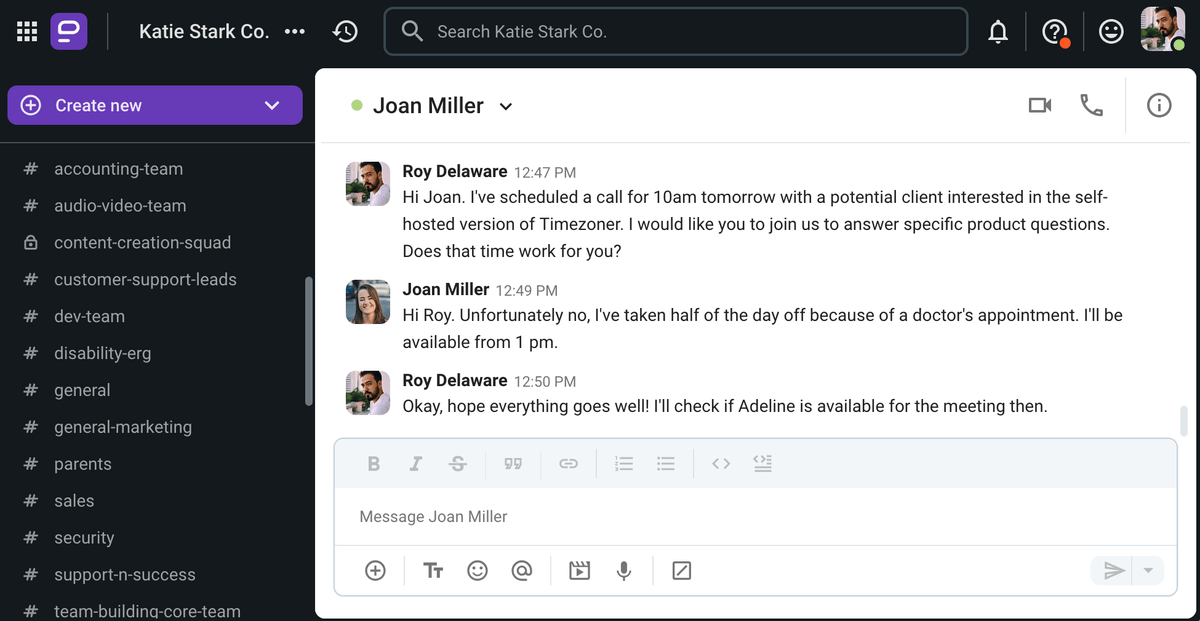
Ce que ressentent les personnes qui communiquent avec des communicateurs assertifs
Les personnes qui communiquent avec des communicateurs assertifs sont susceptibles d'avoir les sentiments suivants :
- Elles peuvent faire confiance au communicateur assertif,
- Elles comprennent ce que la personne essaie de communiquer,
- Elles peuvent exprimer des critiques sans déclencher de réaction négative,
- Elles peuvent respecter la personne et
- Elles n'ont pas besoin de faire des pieds et des mains pour que le communicateur assertif se sente à l'aise et en sécurité.
Conseils pour communiquer avec des communicateurs assertifs
Le mieux que vous puissiez faire lorsque vous communiquez avec des personnes assertives est d'imiter leur style de communication sain et efficace.
Essentiellement, essayez :
- De les écouter attentivement,
- De vous affirmer positivement,
- D’accepter d'être en désaccord avec eux (le cas échéant),
- De leur demander leur avis et
- D'être ouvert et honnête dans la communication.
Un exemple où vous vous affirmez tout en invitant les autres à contribuer serait de dire :
“Je propose que nous choisissions cette palette de couleurs pour le produit. Qu'en pensez-vous ?”
Comment accroître son assertivité dans la communication
Quel que soit votre style de communication, vous pouvez vous efforcer de vous affirmer davantage. Comme l'affirmation de soi repose sur la confiance en soi, vous devez comprendre votre valeur et respecter vos droits, vos besoins et vos désirs, mais vous devez aussi respecter les autres pour réussir à communiquer.
Vous pouvez commencer par exprimer vos opinions, vos idées et vos préoccupations et demander ce que vous voulez directement et sur un ton neutre.
D'autre part, vous ne devez pas laisser votre jugement être obscurci par la frustration et d'autres émotions excessives. Si vous avez besoin de temps pour vous calmer, prenez-le avant d'agir.
Vous pouvez exprimer une critique ou un désaccord sans porter de jugement en utilisant des phrases en “je”. Par exemple, au lieu de dire : “Tu as fait un travail épouvantable !” vous pouvez dire :
“J'ai l'impression que tu aurais pu faire mieux pour ce projet.”
Apprenez à dire “Non” avec fermeté mais poliment. Si votre patron veut vous confier un nouveau projet alors que vous êtes déjà très occupé, vous pouvez dire quelque chose comme ceci :
“Bien que je comprenne l'importance de commencer le projet tôt, je ne pourrai pas commencer à travailler dessus tant que je n'aurai pas terminé mes tâches actuelles.”
Vous pouvez alors proposer un compromis :
“Cependant, je pourrais organiser une réunion rapide avec l'équipe cette semaine pour leur donner quelques indications sur la manière de commencer. Si cela ne fonctionne pas, je peux commencer le nouveau projet lundi à la première heure. Faites-moi savoir ce que vous en pensez.”
Respectez votre temps et vos limites, et faites savoir à votre équipe qu'elle ne peut pas vous contacter pendant votre pause ou en dehors des heures de travail. Au lieu de faire vibrer votre téléphone toutes les deux secondes pendant que vous essayez de déjeuner, mettez les notifications en pause dans le chat de l'équipe.
Sur Pumble, vous pouvez établir un calendrier de notification qui vous convient, de sorte que vous n'ayez pas à le faire manuellement tous les jours.
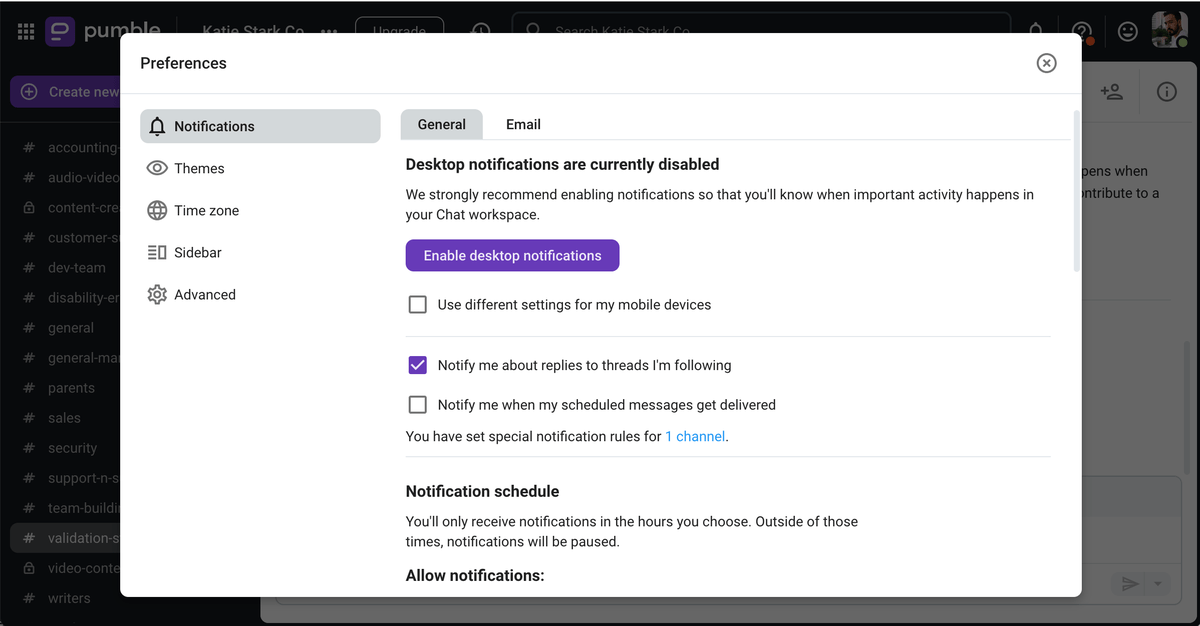
Minimisez les distractions et priorisez le travail important avec Pumble
🎓 Astuce Pro de Pumble
Il peut être difficile de s'affirmer, surtout dans les communications à distance où l'on ne peut pas toujours lire les signaux non verbaux de ses interlocuteurs. Consultez notre article de blog pour apprendre à tracer des limites claires et à communiquer de manière assertive dans tous les cas de figure :
Styles de communication, répartis par Alessandra et Hunsaker (1993)
Selon une autre classification des styles de communication, définie par Alessandra et Hunsaker dans leur livre Communication at Work, nous reconnaissons 4 types de styles de communication, qui sont basés sur 2 dimensions :
- Styles de communication directs vs. indirects et
- Styles de communication de soutien vs. de contrôle.
Les 4 styles de communication en question sont :
- Les relationnistes,
- Les socialisateurs,
- Les penseurs et
- Les dirigeants.
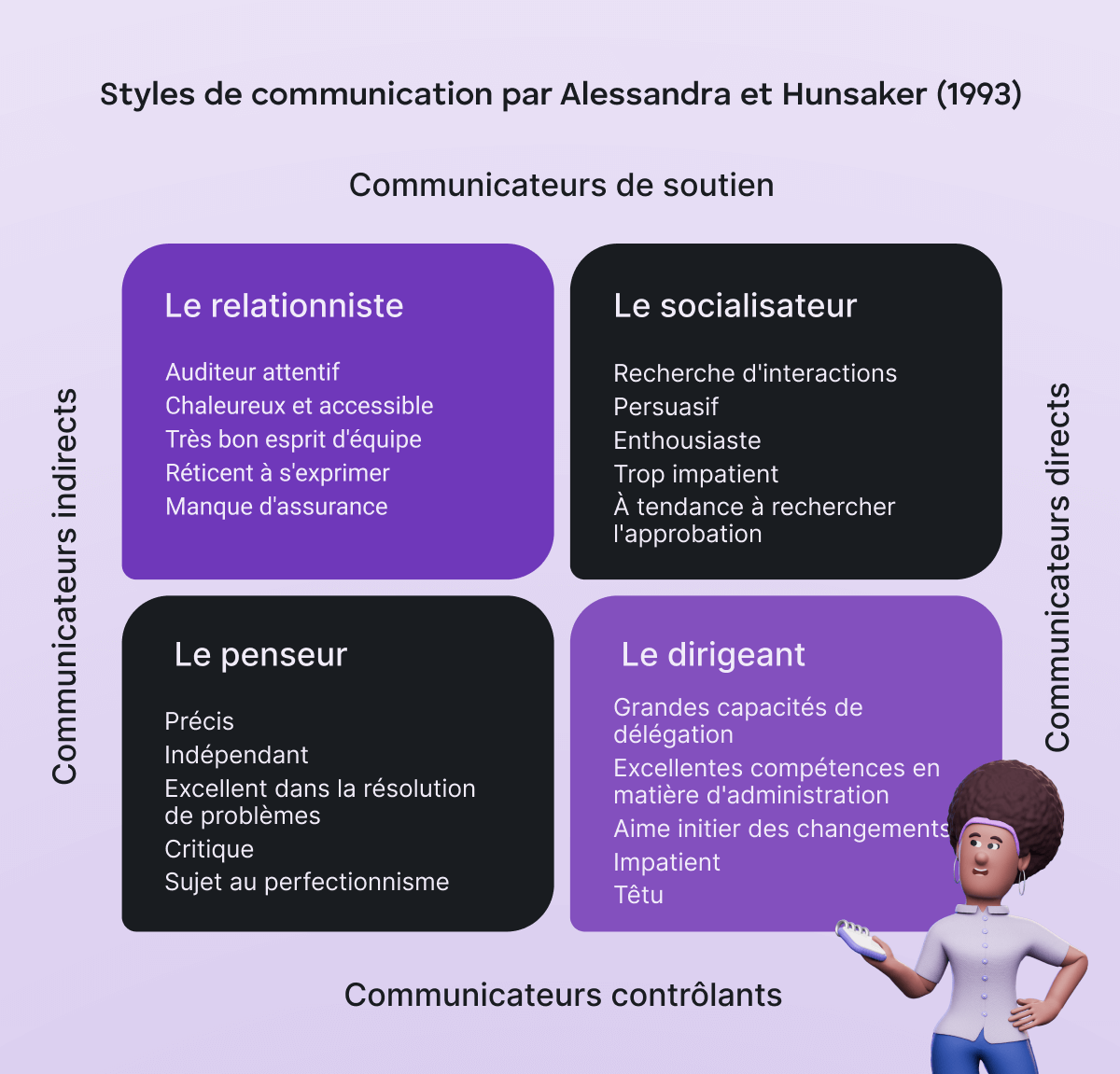
Examinons en détail ce que recouvrent chacun des quatre styles et chacune des deux dimensions.
Styles de communication directe vs. indirecte
La dimension directe vs. indirecte décrit le comportement observable et divise les gens en deux catégories : ceux qui parlent de manière directe et ceux qui parlent de manière indirecte.
Style de communication directe
Les personnes qui parlent directement ont tendance à :
- S'affirmer et prendre les choses en main,
- Dominer les réunions par leur franc-parler,
- Rayonner de confiance en soi,
- Maintenir un contact visuel,
- Avoir des poignées de main fermes,
- Exprimer ouvertement leurs opinions,
- Parler plus vite et plus fort en général,
- Avoir une apparence visuelle audacieuse,
- Parler sur un ton agressif,
- Être impatients,
- Être compétitif et
- Être plus conflictuel en général.
Style de communication indirecte
À l'inverse, les personnes qui parlent indirectement ont tendance à :
- Hésiter à participer aux réunions en raison de leur approche plus hésitante de la communication,
- Prendre moins d'initiatives lors de rencontres sociales,
- Faire précéder leurs déclarations de qualifications telles que “D'après mes sources…” et “Je ne suis pas sûr, mais…”,
- Se conformer sur des sujets sans importance, mais se disputer s'ils ont de fortes convictions sur un sujet,
- Écouter davantage les autres,
- Serrer gentiment la main,
- Être plus réservé,
- Être plus prudent,
- Parler plus lentement et à un volume plus faible,
- Être plus conservateurs dans leur apparence visuelle et
- Être plus patients, diplomates et coopératifs en général.
Styles de communication de soutien vs. de contrôle
La dimension soutien vs. contrôle décrit l'aspect “pourquoi” du processus de communication et indique si les communicateurs soutiennent (orientés vers les personnes) ou contrôlent (orientés vers les tâches).
Les communicateurs de soutien (orientés vers les personnes)
Les communicateurs de soutien (orientés vers les personnes) ont tendance à :
- Maintenir une plus grande proximité avec les personnes avec lesquelles ils communiquent,
- Partager leurs sentiments, en ce sens qu'ils n'ont aucun problème à exprimer la confusion, la joie, la tristesse et d'autres émotions,
- Utiliser des modes d'expression plus informels,
- Préférer des relations détendues et plus chaleureuses,
- Aimer les conversations amusantes,
- Aimer partager des histoires personnelles et des anecdotes,
- Ne pas prêter attention à une personne qui leur fait objectivement perdre leur temps,
- Fonder leurs décisions sur leurs sentiments, mais aussi sur ceux des autres,
- Avoir des expressions faciales actives,
- Avoir des gestes physiques animés et
- Être orienté vers le contact.
Les communicateurs contrôlants (orientés vers les tâches)
Les communicateurs contrôlants (orientés vers les tâches) ont tendance à :
- Garder leurs distances avec les autres pendant la communication,
- Fonder leurs décisions sur des faits,
- Partager moins leurs sentiments,
- Préférer travailler seuls,
- Accorder moins d'attention aux opinions et aux sentiments des autres,
- Exceller dans la gestion du temps,
- Ne pas aimer les digressions,
- Utiliser des modèles de discours plus formels,
- Utiliser moins d'expressions faciales,
- Être sur leurs gardes émotionnellement, physiquement et mentalement,
- Éviter d'être turbulents et
- Éviter d'être bruyants.
Maintenant que nous comprenons les dimensions qui façonnent leur communication, examinons comment communiquent les relationnistes, les socialisateurs, les penseurs et les dirigeants.
n°1 Style de communication des relationnistes
Les relationnistes se caractérisent par un style de communication de soutient et indirect.
Ils se soucient généralement plus des sentiments des personnes avec lesquelles ils communiquent que de l'efficacité de leurs tâches.
Ils ont tendance à :
- Éviter les conflits et
- Apprécier les relations personnelles.
Les traits positifs des relationnistes
Les personnes ayant un style de communication relationnel présentent de nombreux traits positifs, dont les plus courants sont les suivants :
- Avoir l'esprit d'équipe,
- Être loyal à l'égard de leur cause,
- Être prêts à partager les responsabilités,
- Être peu enclins à prendre des risques,
- Exceller dans l'écoute active,
- Planifier tout minutieusement et respecter leurs plans,
- Avoir une attitude détendue et
- Avoir un comportement chaleureux et accessible.
Les traits négatifs des relationnistes
En ce qui concerne les traits négatifs des personnes qui ont un style de communication relationnel, elles ont tendance à :
- Être réticentes à s'exprimer,
- Avoir du mal à se fixer des objectifs,
- Ne pas toujours prendre la parole pour exprimer leurs préoccupations, même si elles ne sont pas d'accord avec ce qui est discuté et
- Manquer d'assurance.
Comment parler avec un relationniste
Lorsque vous discutez avec un relationniste, l'essentiel est de rendre l'interaction personnelle.
Pour tirer le meilleur parti de votre communication avec un relationniste, vous devez également :
- Faire preuve de patience en essayant d'établir un rapport et en attendant que le rapporteur réfléchisse aux points que vous avez soulevés,
- Rechercher un accord mutuel sur les objectifs et les délais,
- Montrer de l'intérêt pour le rapporteur en tant que personne,
- Expliquer comment certains changements et innovations peuvent être bénéfiques pour les rapporteurs,
- Réduir leurs craintes,
- Tenir ses promesses et
- Faire preuve de chaleur dans la communication.
Exemple de communication réussie avec un relationniste
Voyons maintenant comment les caractéristiques susmentionnées se manifestent dans la communication sur le lieu de travail.
Un directeur technique souhaite que son développeur de logiciels complets, qui correspond à la description d'un relateur en termes de style de communication, modifie la fonction de tri de son application de conversion de fuseaux horaires de manière à ce que les villes que l'utilisateur souhaite comparer en termes de fuseaux horaires soient classées par emplacement géographique et non par ordre alphabétique.
Le directeur technique entame la conversation en dévoilant les avantages d'un tel changement et en faisant preuve de patience. Dans le même temps, le développeur full-stack considère la valeur réelle d'une telle fonctionnalité et demande quel est le meilleur moment pour une date limite si la fonctionnalité a été validée.
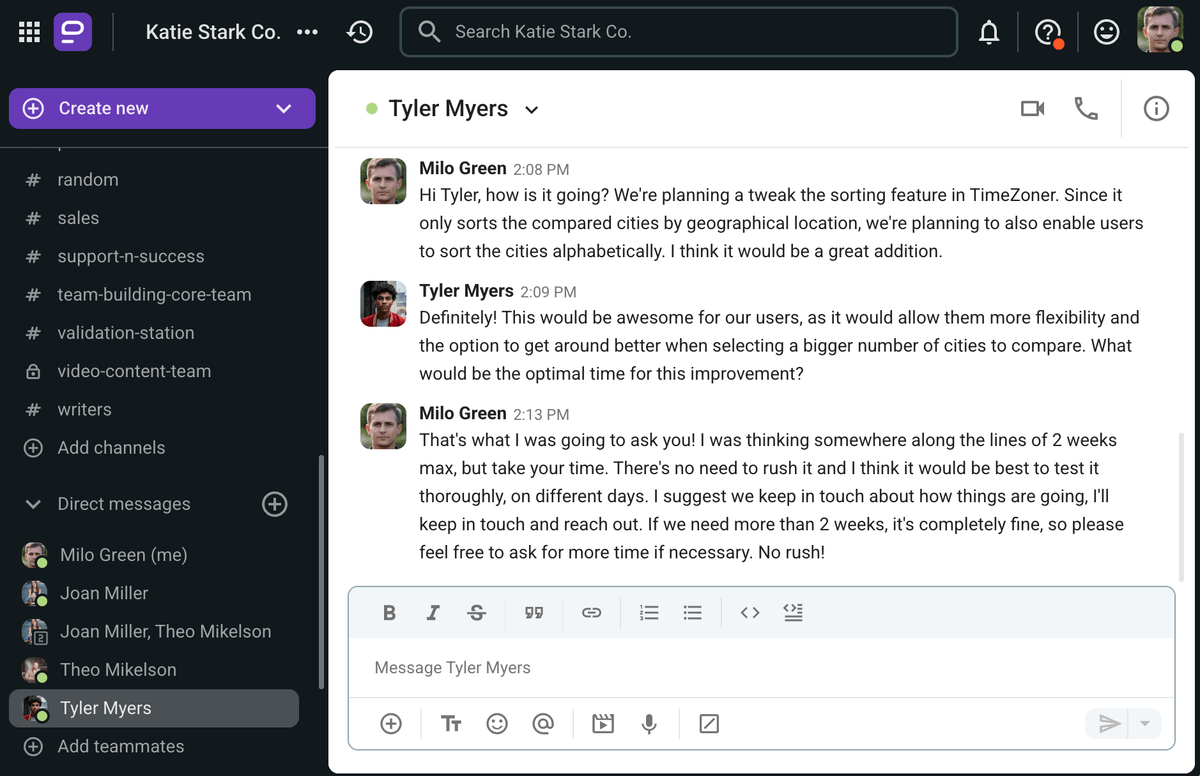
Comment mieux communiquer quand on est un relationnel
La principale chose à retenir si vous voulez améliorer votre communication en tant que personne relationnelle est de ne pas laisser les relations interpersonnelles vous empêcher d'accomplir vos tâches.
Pour améliorer votre communication en tant qu'agent relationnel, vous devez :
- Exprimer vos opinions et vos préoccupations,
- Apprendre à ne pas craindre les conflits,
- Vous rappeler qu'il n'est pas de votre responsabilité de régler les problèmes personnels de chacun,
- Ne pas laisser les émotions obscurcir votre jugement,
- Essayer de vous fixer des objectifs SMART et vous y tenir et
- Vous sentir plus à l'aise avec le changement.
n°2 Style de communication des socialisateurs
Les socialisateurs se caractérisent par un style de communication direct et de soutient.
Leurs stimuli les plus forts sont l'admiration, les compliments et la reconnaissance qu'ils peuvent recevoir des autres. Les socialisateurs ont tendance à influencer et à stimuler les autres de manière amicale et positive.
Leur comportement consiste généralement à :
- Avoir d'interactions et de contacts avec d'autres personnes,
- Agir et prendre des décisions spontanément,
- Agir avec enthousiasme et vivacité,
- Penser de manière émotionnelle,
- Éviter les conflits et
- Aimer les innovations.
Les traits positifs des socialisateurs
En ce qui concerne leurs traits positifs, les socialisateurs sont le plus souvent :
- Faciles à coopérer,
- Bavards,
- Communicatifs,
- Persuasifs,
- Enthousiastes et
- Sociable.
Les traits négatifs des personnes socialisateurs
En ce qui concerne les traits négatifs des personnes qui ont un style de communication socialisant, ces personnes peuvent parfois :
- Passer pour manipulatrices et imprudentes lorsqu'elles adoptent un comportement inadapté à la situation,
- Négliger des faits et des détails cruciaux, ce qui peut les amener à exagérer et à généraliser des questions et des concepts,
- Avoir besoin d'aide pour s'organiser,
- S'impliquer dans un trop grand nombre d'activités,
- Faire preuve d'une faible capacité d'attention,
- Se préoccuper exagérément de l'approbation des autres et
- Être trop impatient.
Comment parler avec un socialisateur
Le point essentiel à garder à l'esprit lorsque vous discutez avec un socialisateur est de rendre l'interaction amusante et vivante.
Pour que l'échange soit agréable et productif, vous devez également :
- Investir du temps dans l'établissement d'une relation avec le socialisateur,
- Passer sur les détails ennuyeux ou sans importance lors de la conversation,
- Définir clairement les tâches et les responsabilités lors des réunions,
- Mettre par écrit ce qui a été convenu lors d'une conversation verbale afin d'aider le socialisateur à se souvenir de ce qui a été convenu,
- Éviter de les critiquer directement et
- Essayer de les motiver en les félicitant quand il le faut.
Exemple de communication réussie avec un socialisateur
Voyons maintenant un exemple d'application des conseils susmentionnés.
Le directeur d'une équipe d'assistance à la clientèle souhaite que son nouveau spécialiste, qui correspond à la description d'un socialisateur en termes de style de communication, prenne en charge son premier ticket.
Tout en fournissant des explications supplémentaires sur le flux de travail attendu (par exemple, “Prenez les tickets dans l'ordre où ils sont ajoutés, sauf s'il y a des tickets marqués comme prioritaires”) et les indicateurs de performance (par exemple, “Visez à traiter les tickets de routine en 30 minutes ou moins”), le directeur de l'assistance clientèle passe les détails et se concentre sur l'essentiel des tâches et des responsabilités du nouveau spécialiste. Le directeur fait également l'éloge de la manière dont le nouveau membre de l'équipe a traité son premier ticket.
Enfin, le directeur envoie un document d'accueil pour que le spécialiste puisse accéder aux flux de travail prévus, aux indicateurs de performance et à d'autres informations relatives à ses fonctions.

Comment devenir un meilleur communicateur lorsque l'on est un socialisateur
En tant que personne sociable, vous n'avez aucun mal à établir des relations avec vos collègues et à les motiver, mais vous devez travailler votre concentration et votre persévérance.
Pour devenir un meilleur communicateur, vous devez :
- Travailler son sens de l'organisation,
- Apprendre à s'auto-valider au lieu de chercher l'approbation des autres,
- Accorder plus d'attention aux détails,
- Veiller à ne pas submerger ou distraire les collègues plus calmes,
- Faire attention à ne pas être manipulateur (par exemple, contraindre quelqu'un à le complimenter) et
- Respecter les limites des autres.
n°3 Style de communication des penseurs
Les penseurs se caractérisent par un style de communication contrôlant et indirect.
Ils se concentrent sur les attentes et les résultats, et basent donc leur communication sur des questions concernant la manière dont quelque chose devrait fonctionner pour déterminer si quelque chose fonctionne réellement.
Ils ont tendance à :
- Poser plus de questions,
- Préférer l'organisation et la structure dans le travail et
- Avoir un mode de pensée logique et orienté vers les tâches.
Les traits positifs des penseurs
Les penseurs présentent plusieurs caractéristiques positives dues à leur style de communication, notamment :
- Être précis,
- Être indépendant,
- Exceller dans la résolution de problèmes et l'organisation,
- Exceller dans l'apport d'éclaircissements et
- Respecter leurs engagements et leurs responsabilités.
Les traits négatifs des penseurs
Lorsque vous réfléchissez aux traits négatifs des personnes ayant ce style de communication, gardez à l'esprit que ces individus ont tendance à :
- Viser toujours avoir raison,
- Être perfectionnistes et trop analyser et
- Être trop critiques s'ils pensent qu'un processus ne se déroule pas comme prévu.
Comment parler avec un penseur
Lorsque vous parlez avec un penseur, l’essentiel est de rendre l’interaction précise.
En outre, vous devez :
- Éviter les bavardages et trop de socialisation,
- Lui donner le temps de réfléchir à ce dont vous parlez avant de répondre,
- Être prêt à répondre aux questions avec précision,
- Être prêt à fournir des chiffres et des faits supplémentaires,
- Mettre par écrit ce que vous avez convenu et
- Tenir vos promesses.
Exemple de communication réussie avec un penseur
Que se passe-t-il lorsque deux penseurs se rencontrent ? Il est temps de le découvrir avec notre exemple.
Deux professeurs d’histoire discutent des plans de cours pour la semaine suivante.
Comme ils correspondent tous deux à la description des penseurs en termes de style de communication, ils évitent les bavardages, se concentrent sur des détails précis (par exemple, le nombre de minutes qu’ils prévoient de consacrer à chaque activité en classe) et écrivent ce sur quoi ils se sont mis d’accord, au fur et à mesure qu’ils s’en mettent d’accord.
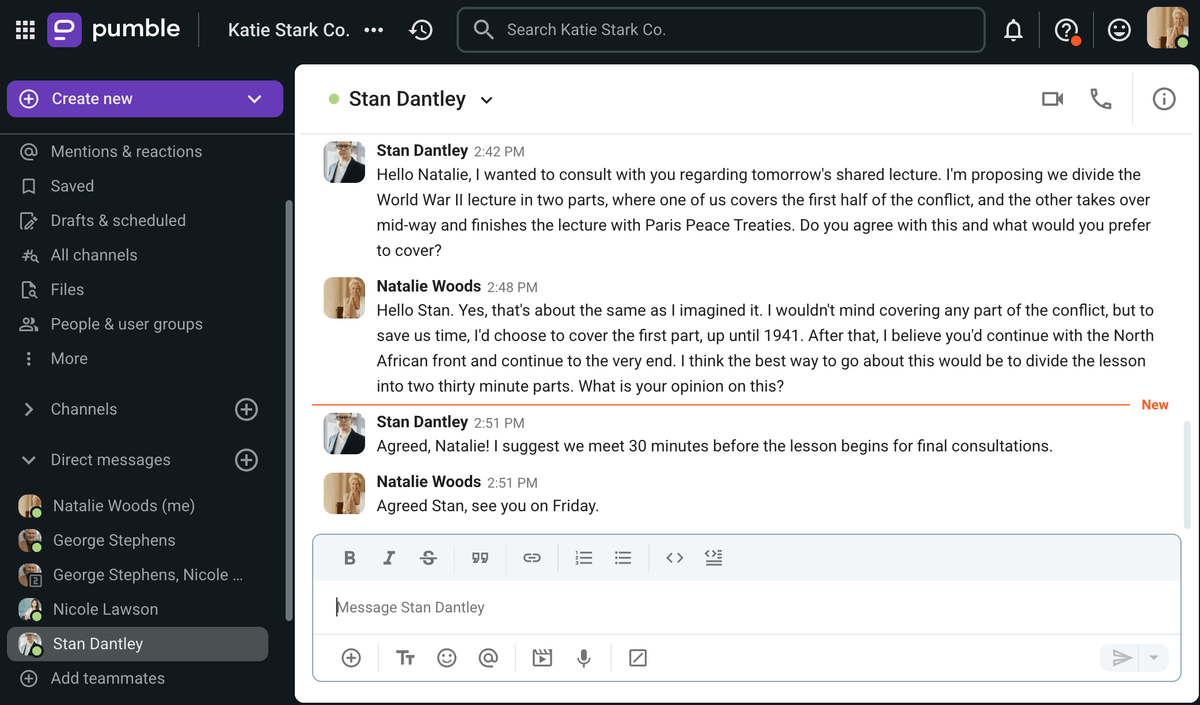
Partagez des idées avec vos collègues sur Pumble
Comment devenir un meilleur communicateur quand on est un penseur
Le plus grand défi en matière de communication pour les penseurs est qu’ils sont trop ancrés dans les faits et les chiffres. Ils pourraient bénéficier d’un relâchement de temps en temps.
Pour devenir de meilleurs communicateurs, les penseurs doivent :
- Essayer de discuter de temps en temps avec leurs collègues autour de la machine à café,
- Apprendre à s’éloigner des détails et à regarder la situation dans son ensemble,
- Accepter qu’ils n’ont pas toujours raison,
- Travailler à surmonter le perfectionnisme car il peut être débilitant et rendre leurs idées rigides,
- S’efforcer de devenir plus ouverts au changement et
- Prendre plus de risques.
n°4 Style de communication des dirigeants
Les dirigeants se caractérisent par un style de communication direct et autoritaire.
Ils sont généralement décrits comme des leaders orientés vers l'action qui se concentrent principalement sur les résultats.
En général :
- Ils aiment avoir le contrôle lors de la communication,
- Ils ont de bonnes compétences en leadership et
- Ils préfèrent agir plutôt qu'attendre.
Les qualités positives des dirigeants
Les personnes ayant ce style de communication sont bien adaptées aux postes de direction en raison de leurs qualités positives, notamment :
- Être indépendant,
- Travailler rapidement, même seul,
- Faire un effort supplémentaire pour surmonter les obstacles le plus rapidement possible,
- Avoir de grandes compétences en matière de délégation,
- Avoir d'excellentes compétences en administration et
- Initier des changements.
Les traits négatifs des dirigeants
Ce style de communication comporte également quelques traits négatifs. À savoir, les directeurs peuvent souvent :
- Être têtus,
- Être impatients,
- Être durs et
- Avoir une faible tolérance aux sentiments des autres.
Comment parler avec un dirigeant
Lorsque vous parlez avec un directeur, essayez de rendre l'interaction rapide.
Pour vous assurer qu'aucun incident ou erreur ne vienne perturber la communication, vous devez également :
- Être clair,
- Être précis,
- Être concret,
- Être prêt à fournir des solutions rapides,
- Fournir des guides étape par étape sur la manière d'atteindre les objectifs,
- Éviter les disputes émotionnelles,
- Éviter les bavardages,
- Éviter de divulguer trop de détails et
- Souligner les points cruciaux.
Exemple de communication réussie avec un dirigeant
Examinons comment se déroulerait un échange réussi avec un dirigeant avec l’exemple ci-dessous.
Une directrice marketing rencontre le PDG de l’entreprise — qui correspond à la description d’un directeur en termes de style de communication — pour discuter des stratégies marketing pour la période à venir.
Pour exprimer ce qu’elle veut le plus efficacement possible, la directrice marketing montre un guide étape par étape sur la façon dont la stratégie marketing qu’elle propose peut aider l’entreprise à atteindre ses objectifs.
Elle fait également des efforts supplémentaires pour être claire, précise, concrète et rapide et pour ne mettre en évidence que les détails cruciaux.

Comment devenir un meilleur communicateur quand on est dirigeant
Un dirigeant peut être un preneur de risques intrépide qui accomplit son travail efficacement, mais son plus gros problème en matière de communication est qu’il peut paraître agressif et intimidant.
S’ils veulent devenir de meilleurs communicateurs, les dirigeants doivent faire ce qui suit :
- Essayer d’être plus attentif aux sentiments des autres,
- Être plus ouvert aux idées et aux critiques des autres,
- Essayer d’établir de véritables relations avec vos collègues,
- Travailler sur vos compétences en matière de collaboration et
- S’efforcer de devenir plus patient.
🎓 Astuce Pro de Pumble
Les dirigeants sont le plus souvent à la tête d'une équipe. Si vous souhaitez essayer un autre style de communication en matière de leadership, consultez le site suivant :
Styles de communication, répartis par Murphy et al.
Mark Murphy et son équipe, qui ont passé une décennie à étudier la communication interpersonnelle, reconnaissent 4 styles de communication :
- Analytique,
- Intuitif,
- Fonctionnel et
- Personnel.
Ces styles de communication décrivent la manière dont nous préférons communiquer des informations.
Selon un article et une enquête de Forbes jusqu'à 42% des personnes interrogées qui s'identifient à au moins l'un des styles de communication mentionnés ci-dessus citent les différences entre ces styles comme la principale cause de mauvaise communication au travail.
Mais, en revanche, jusqu'à 52% des personnes interrogées déclarent également qu'elles aiment communiquer avec des personnes qui ont des styles de communication différents. Il y a donc de l'espoir pour un effort conscient visant à minimiser la mauvaise communication.

Voici en quoi consiste chacun de ces styles de communication de manière plus détaillée, tels que décrits par Murphy et son équipe.
n°1 Style de communication analytique
Les personnes qui ont un style de communication analytique se concentrent sur les données.
En communication, elles apprécient les personnes qui utilisent un langage spécifique et aiment discuter de faits et de chiffres. Si vous n’avez pas les faits et les chiffres pour étayer vos affirmations, vous risquez de perdre votre crédibilité aux yeux d’un communicateur analytique.
Exemple de communication avec un communicateur analytique
Examinons maintenant comment fonctionne une approche basée sur les données dans la communication sur le lieu de travail.
Au cours d’une réunion quotidienne, un spécialiste des ventes déclare que ses conclusions montrent que “les ventes sont positives”. Le directeur des ventes n’est pas satisfait de cette formulation et demande : “Que signifient les ventes positives ? Sont-elles positives de 10% ? Ou de 5% ? Quels sont les chiffres exacts ?”
Le principal aspect positif du style de communication analytique
Étant donné que les communicateurs analytiques sont capables d'avoir une vision dénuée d'émotions d'une situation, ils sont également capables d'analyser et de tirer des conclusions sur les problèmes de manière :
- Logique,
- Factuelle et
- Objective.
Dans le même ordre d'idées, une vision trop peu émotionnelle des situations peut faire passer les communicateurs analytiques pour des personnes froides ou distantes, en particulier les communicateurs personnels.
Le principal aspect négatif du style de communication analytique
Comme mentionné précédemment, pour attirer l’attention d’un communicateur analytique, vous devez être direct et précis. Il n’apprécie pas que ses interlocuteurs s’égarent dans des détours et des données non pertinentes, alors restez concentré.
Vous devez également :
- Éviter les bavardages,
- Vous concentrer sur les affaires et
- Éviter les sujets personnels.
N’oubliez jamais que les communicateurs analytiques ne sont pas du genre à offrir une épaule sur laquelle pleurer.
Conseils de communication pour les communicateurs analytiques
En tant que communicateur analytique, vous pourriez bénéficier d’une attitude plus amicale envers vos collègues et d’une plus grande tolérance envers les personnalités plus bavardes et plus chaleureuses.
Comprenez que tout le monde ne traite pas les informations comme vous et n’a pas une propension à traiter les chiffres, et essayez d’être plus patient lorsque quelqu’un est distrait.
n°2 Style de communication personnel
Les personnes qui ont un style de communication personnel se concentrent sur les émotions.
En communication, les communicateurs personnels valorisent le langage émotionnel et l'établissement d'un lien avec les personnes avec lesquelles ils communiquent.
En conséquence, ils ont tendance à être diplomates et excellent dans l'écoute, car ils accordent une grande valeur à l'évaluation de la façon dont les autres pensent et ressentent.
Exemple de communication avec un communicateur personnel
Pourquoi voudriez-vous qu'un communicateur personnel rejoigne votre équipe ou votre organisation ? Examinez l'exemple ci-dessous et décidez par vous-même.
Alors qu'ils discutent de la palette de couleurs de leur nouveau produit, une créatrice de produits remarque que son nouveau concepteur de produits junior semble contrarié d'être ignoré pour ses idées.
Par conséquent, elle s'efforce de faire en sorte que le concepteur de produits junior se sente mieux intégré et apprécié en s'adressant à lui et en lui demandant son avis.
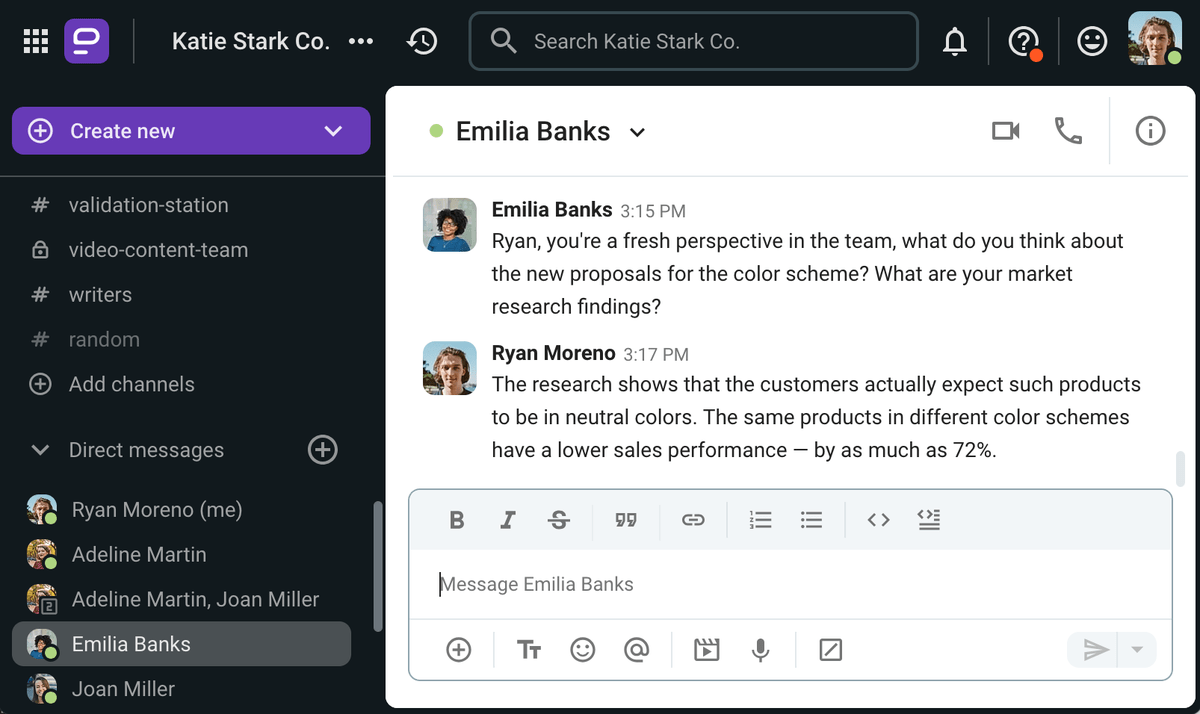
Brainstorming efficace sur Pumble
Le principal aspect positif du style de communication personnel
Les communicateurs personnels servent souvent de ciment qui maintient tout ensemble : ils sont à l’écoute des sentiments et des opinions des autres, ce qui les aide à aplanir les conflits et à encourager les autres à partager des idées et des opinions.
Le côté émotionnel des communicateurs personnels est à la fois leur avantage et leur inconvénient : ils peuvent être considérés comme des individus trop émotifs qui peuvent facilement s'énerver, en particulier du point de vue des communicateurs analytiques.
De plus, leur côté émotionnel peut les pousser à éviter les conflits, même lorsqu'une bataille d'opinions pourrait être le résultat le plus productif.
Conseils pour communiquer avec un communicateur personnel
Avant de vous lancer dans des affaires avec des communicateurs personnels, il est préférable de prendre un peu de temps pour apprendre à les connaître et les reconnaître en tant qu’êtres humains.
Faites-leur sentir que leur point de vue est précieux et demandez-leur régulièrement ce qu’ils pensent d’une certaine idée, d’une décision ou autre. N’hésitez pas à utiliser un langage chargé d’émotion et à éviter de parler de manière pragmatique.
Conseils de communication pour les personnes qui ont une attitude personnelle
Lorsque vous parlez à vos collègues plus analytiques, essayez de ne pas prendre leur manière directe et professionnelle personnellement. Respectez le fait que certaines personnes ne souhaitent pas s’engager dans des relations chaleureuses et conviviales, surtout au travail.
N’hésitez pas non plus à exprimer votre désaccord simplement parce que vous craignez que cela ne débouche sur un conflit.
n°3 Style de communication intuitif
Les personnes qui ont un style de communication intuitif se concentrent sur la vision globale.
En communication, elles n'aiment pas les détails excessifs et préfèrent les aperçus généraux à une mise en ordre parfaite des événements ou à des explications du problème ou de la situation.
Elles sont orientées vers l'action et se concentrent davantage sur les résultats que sur le processus qui les y conduira. Dans cette optique, elles privilégient les conversations brèves qui vont droit au but.
Exemple de communication avec un communicateur intuitif
Comme vous l’aurez deviné, un communicateur intuitif évite souvent que les conversations ne déraillent, comme le montre notre exemple.
Lors d’un rendez-vous individuel entre un agent des services financiers et un conseiller financier, l’agent des services financiers commence à dévoiler des détails sur le compte d’un client qui souhaite investir en bourse. Le conseiller financier trouve que les détails sont excessifs et s’exclame : “Concentrons-nous simplement sur la situation financière actuelle du client et partons de là.”
Le principal aspect positif du style de communication intuitif
Étant donné que les communicateurs intuitifs préfèrent les conversations directes, ils ne s’emmêleront pas dans des détails insignifiants.
Leur habitude de voir les choses dans leur ensemble peut également les aider à trouver des solutions innovantes et nouvelles à de vieux problèmes qui souffrent de processus inefficaces.
Cependant, la brièveté que privilégient les communicateurs intuitifs dans leurs communications signifie qu'ils peuvent manquer de patience dans les situations qui nécessitent une approche plus détaillée et prolongée.
Dans de tels cas, ces communicateurs peuvent manquer un détail crucial en regardant la situation dans son ensemble, ce qui peut particulièrement frustrer les communicateurs fonctionnels.
Conseils pour communiquer avec un communicateur intuitif
Si vous voulez capter l’attention de ce type de communicateur, vous devez le décrire en grandes lignes, sinon vous le perdrez.
Cela est particulièrement important si vous essayez de lui présenter une idée : ne l’embêtez pas avec les détails de la planification et de l’exécution.
Concentrez-vous plutôt sur le pourquoi et envoyez-lui le comment par email plus tard.
Conseils de communication pour les communicateurs intuitifs
C’est formidable d’être un visionnaire et une personne d’action, mais vous devez également vous intéresser aux processus et pas seulement aux résultats.
Ces informations vous aideront à découvrir les éventuels goulots d’étranglement, voire les obstacles, avant qu’il ne soit trop tard et vous permettront de mieux expliquer vos idées.
n°4 Style de communication fonctionnel
Les personnes qui ont un style de communication fonctionnel se concentrent sur les processus.
Les communicateurs fonctionnels n'aiment pas les conversations directes et rapides préférées des communicateurs intuitifs.
Au contraire, ils aiment se concentrer sur les détails et les processus et prendre leur temps pour rechercher des solutions et de nouvelles idées.
Exemple de communication avec un communicateur fonctionnel
La situation ci-dessous montre comment l’approche axée sur les détails des communicateurs fonctionnels affecte la conversation.
Le chef du service de montage s'entretient avec un vidéaste qui crée une nouvelle vidéo de marketing.
Le chef du service pose des questions sur les détails et prend plus de temps pour déterminer tout ce qui peut être important pour la vidéo et son objectif.
Tout en cherchant l'approche appropriée, le chef du service d'édition est :
- Méthodique,
- Axé sur les processus et
- Soucieux du détail.

Le principal aspect positif du style de communication fonctionnel
Il est peu probable qu’un communicateur fonctionnel passe à côté de détails cruciaux dans un concept, une idée ou un plan, aussi petits et insignifiants que ces détails puissent paraître aux autres.
Étant donné qu’ils préfèrent prendre leur temps pour réfléchir ou expliquer quelque chose, les communicateurs fonctionnels risquent de perdre l’attention de leur public cible — surtout si ce public comprend des communicateurs intuitifs.
Conseils pour communiquer avec un communicateur fonctionnel
Lorsque vous souhaitez discuter d'une idée avec un communicateur fonctionnel, mieux vaut être préparé ! Il voudra entendre tous les détails techniques et trouvera facilement des failles dans votre plan.
D'un autre côté, vous pouvez utiliser sa rigueur pour tester la viabilité de vos idées. N'hésitez pas à laisser de côté les grands discours et les sérénades et à vous concentrer sur le côté pratique du problème en question.
Conseils de communication pour les communicateurs fonctionnels
Essayez d’évaluer les situations sociales qui nécessitent des explications approfondies et celles qui n’en nécessitent pas.
Par exemple, si vous essayez de vendre une idée ou un produit, vous ne voulez pas ennuyer les acheteurs potentiels avec les instructions techniques lors de la première réunion.
Vous pouvez laisser cette partie aux discussions internes de votre équipe et vous concentrer plutôt sur la façon dont votre produit correspondra à leur vision ou à leurs besoins.
Styles de communication sur le lieu de travail, répartis par Cox
Dans son livre Negotiations : How to Achieve Win-Win Outcomes, l'auteur et consultant en formation Geof Cox aborde la communication efficace en décrivant 4 types distincts de styles de communication.
En matière de communication sur le lieu de travail, Cox explique que les gens utilisent le plus souvent l'un des styles de communication suivants :
- Le style axé sur l'action,
- Le style axé sur le processus,
- Le style axé sur les personnes et
- Le style axé sur les idées.
Dans des situations telles que les négociations et les réunions d'affaires, le succès de l'échange réside dans notre capacité à nous adapter et à adopter rapidement différents styles de communication.
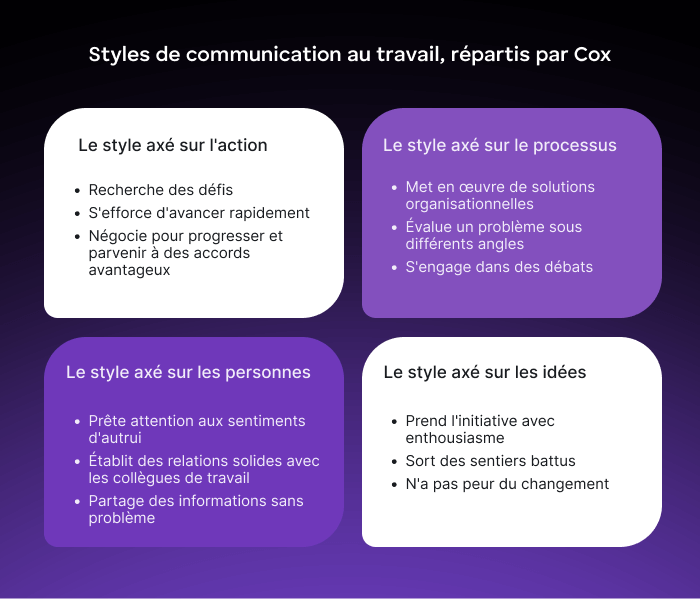
Il est donc essentiel d’examiner en détail les styles de communication ci-dessus et d’en apprendre davantage sur leurs points forts et leurs éventuels inconvénients.
n°1 Style orienté vers l'action
L'état d'esprit des personnes orientées vers l'action les pousse à accomplir leurs tâches et à obtenir de bons résultats. Ces communicateurs n'ont pas peur du changement et de faire des vagues et s'efforcent de transformer leurs plans en actions pour améliorer leur situation actuelle.
Le comportement commun des communicateurs axés sur l’action
En général, les personnes qui préfèrent le style orienté vers l’action présentent les comportements suivants :
- Ils mentionnent souvent les challenges et les moyens possibles d’avancer,
- Ils peuvent se concentrer sur les réalisations et les résultats au détriment des sentiments de leurs collègues,
- Ils peuvent s’impatienter avec les personnes qui s’appuient sur un style de communication différent,
- Ils ont généralement peu de difficultés à maîtriser leur charge de travail et à respecter les délais et
- Ils négocient volontiers avec les autres pour parvenir au meilleur accord possible.
Exemple de communication axée sur l’action
Comment se déroule l’utilisation de ce style de communication sur le lieu de travail ? Voyons ce que montre notre exemple.
Le directeur marketing d’une agence de marketing de premier plan rencontre le directeur technique d’une grande entreprise technologique.
Les deux entreprises ont un historique de collaboration, et le directeur marketing dit au directeur technique : “Si vous investissez dans notre nouvelle entreprise, nous augmenterons de 20% la publicité de vos produits sur tous nos sites.”
Le directeur marketing utilise un comportement d’échange et d’exigence pour conclure un accord qui profitera aux deux parties.
Les avantages d’une communication axée sur l’action
Ceux qui ont un état d’esprit orienté vers l’action aiment que les conversations soient courtes et simples.
Au lieu de s’engager dans de petites conversations pour faciliter l’entrée en réunion, ils vont probablement aller droit au but, ce qui rend tous les types de réunions et de conversations plus productifs et empêche les autres de s’écarter du sujet.
De plus, ce style de communication peut être utile car il :
- Permet aux personnes d’atteindre leurs objectifs en moins de temps,
- Aide l’orateur à couvrir rapidement beaucoup de terrain et
- Donne à la conversation un ton énergique.
Les inconvénients de la communication axée sur l'action
Les communicateurs axées sur l'action veulent avant tout faire avancer les choses.
Malheureusement, bien que cela soit inestimable sur n'importe quel lieu de travail, un tel état d'esprit peut amener les autres à percevoir le communicateur comme :
- Arrogant,
- Insensible aux opinions et aux sentiments de ses collègues ou collègues,
- Dictatorial et
- Désintéressé par tout autre chose que les résultats.
En bref, s'appuyer trop fortement sur le style de communication orienté vers l'action pourrait faire croire aux gens que vous souhaitez atteindre vos objectifs sans offrir de contributions significatives en retour.
Comment parler avec des communicateurs axées sur l'action
Lorsque vous discutez avec un communicateur orienté vers l'action, la dernière chose que vous voulez faire est de l'ennuyer avec des détails superflus.
Dès qu'il se sent bombardé d'informations inutiles, vous risquez de le perdre dans les conversations.
Pour tirer le meilleur parti de ces échanges, essayez de :
- Utilisez des supports visuels pour faire passer votre message,
- Mentionnez d'abord les résultats attendus, puis poursuivez avec des conclusions supplémentaires,
- Mettez en évidence les valeurs pratiques de vos plans et idées et
- Soyez bref.
Comment améliorer la communication si vous utilisez le style axé sur l’action
Comme nous l’avons mentionné, il est déconseillé d’abuser de ce style. Heureusement, les personnes qui adoptent ce style peuvent améliorer leur communication de plusieurs manières, notamment :
- Être patient lorsqu’on parle à des personnes qui préfèrent un style de communication différent,
- Prendre en compte les sentiments des autres lors de la prise de décisions et de l’élaboration des réponses et
- Écouter les idées et les commentaires des autres personnes sans les interrompre.
n°2 Style orienté vers le processus
Les personnes qui utilisent un style de communication orienté processus souhaitent parvenir à des solutions logiques. Contrairement aux individus qui ont un état d'esprit orienté action, ces communicateurs sont moins agressifs et utilisent plutôt des arguments rationnels pour atteindre les résultats souhaités.
Le comportement commun des communicateurs axées sur le processus
Les communicateurs orientés processus se concentrent généralement sur les éléments suivants :
- Établir des systèmes organisationnels efficaces,
- Aborder une situation sous tous les angles possibles pour trouver une résolution optimale et
- Participer à des débats.
Exemple de communication axée sur le processus
Bien que les gens devraient éviter d’abuser de ce style de communication, il est indéniable qu’il peut être bénéfique, en particulier lors de l’élaboration d’un plan d’affaires détaillé.
Regardez l’exemple ci-dessous dans lequel un assistant marketing discute avec son chef d’équipe des canaux publicitaires possibles pour sa nouvelle campagne. Remarquez comment l’assistant marketing passe en revue chaque détail. Sa réponse porte toutes les caractéristiques des communicateurs orientés processus.

Collaborer efficacement avec Pumble
Les avantages de la communication axée sur le processus
Le style de communication orienté processus est un excellent recours à des fins commerciales car il :
- Encourage la participation de toutes les parties présentes,
- Minimise le risque de prendre des décisions mal informées et hâtives et
- S'appuie sur des données, des faits et des analyses.
Les inconvénients de la communication axée sur le processus
Bien que les communicateurs orientés processus aiment peser tous les aspects d’un argument ou d’une proposition, leur style de communication présente plusieurs inconvénients.
Dans leur désir d'évaluer une situation de manière logique et approfondie, les individus qui utilisent un style de communication axé sur les processus :
- Peuvent sombrer dans la verbosité,
- Peuvent créer une atmosphère fastidieuse et
- Peuvent organiser des réunions qui s'éternisent avant d'arriver à une résolution.
Comment parler avec des communicateurs axés sur les processus
Certains peuvent se sentir démunis lorsqu’ils parlent avec des communicateurs axés sur les processus, car ce style de communication utilise de nombreux faits, données et raisonnements.
Pour garantir que la conversation se déroule sans accroc, il est préférable de :
- Décomposer votre idée ou votre proposition en faits et détails les plus importants,
- Suivre un plan logique lorsque vous parlez et
- Développer d’abord la situation actuelle et passer ensuite aux résultats attendus.
Comment améliorer la communication si vous êtes un communicateur orienté processus
Il est toujours bon d’avoir des faits et des données clairs, mais se concentrer trop sur les détails peut nuire à la vue d’ensemble.
Au lieu de cela, essayez les conseils suivants :
- Limitez-vous à utiliser un maximum de trois faits pour étayer une proposition, une décision ou une opinion,
- Déléguez des tâches à d’autres afin de ne pas avoir à passer trop de temps à analyser un problème sans aide,
- Arrêtez-vous lorsque vous réalisez que vous avez parlé trop longtemps et
- Demandez aux autres de fournir des commentaires et des feedbacks.
n°3 Style orienté vers les personnes
Les personnes qui ont un style de communication axé sur les personnes sont à l’écoute des besoins des autres et s’efforcent consciemment de ne pas porter atteinte aux droits de tous les participants à la conversation.
Ce sont des personnes compréhensives et empathiques dont les principes directeurs incluent le travail d’équipe et un solide sens de l’éthique.
Comportement commun des communicateurs axés sur les personnes
Empathiques et sensibles, les communicateurs ayant ce style s'efforcent de :
- Comprendre les sentiments et les motivations des autres personnes,
- Établir des relations solides avec les collègues et les collègues et
- Partager ouvertement des informations avec les autres pour instaurer la confiance.
Exemple de communication axée sur les personnes
Comment se déroule la communication axée sur les personnes au travail ? Nous pouvons utiliser la conversation ci-dessous comme exemple.
Dans l'exemple suivant, un développeur d'applications contacte son chef d'équipe via Pumble, une application de communication d'entreprise. Notez la manière dont il rédige son message.

Dans la première partie du message, le développeur exprime ses sentiments sur la situation actuelle, ce qui constitue un partage.
D'autre part, la dernière partie du message invite le chef d'équipe à partager des informations, démontrant ainsi que le développeur est prêt à écouter sa réponse.
Étant donné que le partage et l'écoute forment un cycle dans la communication axée sur les personnes, ce style est une stratégie commerciale utile.
🎓 Astuce Pro de Pumble
La communication d'entreprise peut sembler complexe et comprendre ses tenants et aboutissants peut être un défi. Consultez notre guide du débutant en communication d'entreprise pour en savoir plus et résoudre toutes les questions persistantes :
Les avantages d'une communication axée sur les personnes
Le style de communication axé sur les personnes repose sur le partage et l'écoute.
Lorsque nous nous ouvrons aux autres, nous les invitons à nous faire confiance, ce qui les oblige à en révéler davantage sur leurs propres sentiments et valeurs.
En matière de communication sur le lieu de travail, une telle approche peut améliorer considérablement la prise de décision, en particulier lors de la négociation d'un accord ou de la rédaction d'une proposition.
De plus, le style de communication axé sur les personnes :
- Crée un environnement positif dans lequel les participants à la conversation se sentent vus et entendus,
- Renforce l'esprit d'équipe et la communication,
- Favorise l'écoute empathique et
- Établit des relations.
🎓 Astuce Pro de Pumble
Construire une équipe solide et harmonieuse repose sur la confiance comme vertu numéro un, mais cela peut être particulièrement difficile dans un environnement de travail à distance. Lisez ce sujet et apprenez à entretenir une relation de confiance sur le lieu de travail :
Les inconvénients de la communication axée sur les personnes
Que vous communiquiez avec un partenaire commercial potentiel ou un client de longue date, ce style de communication est une excellente stratégie qui peut fournir des informations précieuses.
Cependant, cela peut également entraîner plusieurs problèmes, dont certains incluent :
- Le partage excessif : cela peut détériorer la confiance lorsque les gens se sentent bombardés d’informations inutiles et
- L’écoute sélective ou trop attentive : vous pouvez essayer de surcompenser lorsque vous vous ouvrez trop en écoutant trop attentivement. Ou bien, vous pouvez oublier de prêter une attention particulière à ce que les autres disent. Dans les deux cas, les autres personnes pourraient avoir l’impression que vous essayez de les manipuler.
Comment parler avec des communicateurs axés sur les gens
Les communicateurs axés sur les gens sont généralement amicaux et accessibles, il est donc facile de contourner les obstacles de communication relativement rapidement.
Les conseils suivants vous aideront à garantir que la conversation se déroule sans heurts :
- Posez des questions de suivi après qu'ils ont fini de parler pour montrer que vous avez prêté attention à leurs paroles,
- Observez leurs signaux verbaux et non verbaux pour interpréter leur message et
- Lorsque vous avez besoin de clarifier si vous les avez bien compris, résumez le point de vue du communicateur et demandez confirmation.
n°4 Style orienté vers les idées
Les personnes qui adoptent un style de communication axé sur les idées voient le monde en termes de :
- Modèles,
- Concepts,
- Théories et
- Abstractions.
Elles ont généralement une approche orientée vers l’avenir et sont toujours à la recherche de nouvelles possibilités.
Le comportement commun des communicateurs axés vers les idées
Qu’ils travaillent sur des objectifs professionnels ou personnels, les communicateurs orientés vers les idées le plus souvent :
- N’ont pas peur de prendre les devants pour donner vie à leur vision,
- Sont des penseurs créatifs prêts à essayer des solutions nouvelles et innovantes,
- Ne craignent pas le changement,
- Sont courant des derniers développements dans leur domaine d’intérêt et
- Essayent d’inspirer leurs collègues et collègues à sortir des sentiers battus.
Exemple de communication axée sur les idées
L’exemple ci-dessous souligne à la fois les avantages et les inconvénients de la communication axée sur les idées.
Le propriétaire d’une école de langues discute avec le copropriétaire et lui fait part de ses projets de refonte de ses plans de cours.
Le propriétaire déclare : “Les PDF mis à jour peuvent inclure des codes QR qui mènent à des exercices interactifs en ligne, et nous pouvons ajouter des éléments visuels attrayants récapitulant l’essentiel des leçons.”
Bien que ces idées semblent être de bonnes idées, il n’est fait aucune mention d’un délai ou de la question de savoir si les employés ont les compétences techniques nécessaires pour réussir cet exploit.
Les avantages d’une communication axée sur les idées
Les personnes qui adoptent un style de communication axé sur les idées ont le sentiment d’avoir fait de leur mieux lorsque la collaboration est à son maximum.
Par conséquent, certains des avantages de ce type de communication sont les suivants :
- Une vision commune qui aide les membres de l’équipe à rester sur la bonne voie,
- Des liens solides entre les personnes qui collaborent au quotidien,
- Le recentrage de l’attention des collègues sur la situation dans son ensemble et
- Une coopération renforcée, car plusieurs personnes ont concentré leurs efforts dans la même direction.
Les inconvénients de la communication axée sur les idées
Comme les autres styles de communication évoqués précédemment, le style de communication axé sur les idées n'est pas toujours idéal pour tous ses avantages.
En particulier, l'utilisation excessive de ce style de communication peut :
- Ne pas réussir à rassembler les gens autour d'une vision commune et
- Conduire à des opportunités gaspillées s'il dirige l'énergie dans la mauvaise direction.
Comment parler avec des communicateurs axés sur les idées
Lorsque vous vous connectez à une personne axée sur les idées, n'oubliez pas de garder la réflexion conceptuelle au cœur de la conversation et :
- Expliquez comment votre idée se rapporte à des problèmes plus vastes,
- Expliquez ce qui rend votre idée innovante et unique et
- Soulignez la valeur à long terme de votre proposition.
Comment améliorer la communication si vous avez un état d'esprit axé sur les idées
Pour éviter d'être victime d'objectifs irréalistes et de plans ambitieux, gardez les points suivants à l'esprit si vous êtes une personne axée sur les idées :
- Réfléchissez plus en profondeur à votre idée,
- Assurez-vous que votre proposition plaît à vos collègues ou à vos collègues,
- Fixez des attentes réalistes,
- Fixez des délais pour rester responsable et
- Travaillez à consolider un plan d'action dès que possible.
4 types de styles de communication, division par Portolese Dias
Dans son livre Human Relations Management, l'auteure Laura Portolese Dias reconnaît qu'en plus des systèmes de communication organisationnels, les individus s'appuient également sur leurs styles de communication personnels.
Portolese Dias continue en reconnaissant 4 styles distincts, qui sont :
- Le style de communication expressif,
- Le style de communication conducteur,
- Le style de communication relateur et
- Le style de communication analytique.
N’oubliez pas que, comme Portolese Dias l’informe à ses lecteurs, aucune personne n’utilise un seul style de communication.
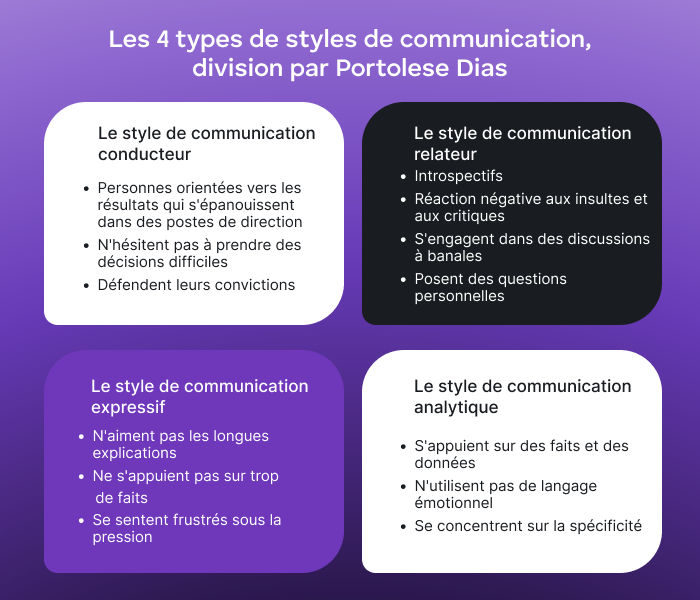
Ce fait, à son tour, augmente l'importance d'identifier vos modes de communication préférés et les avantages et inconvénients des autres styles.
n°1 Style de communication expressif
Les personnes qui ont un style de communication expressif sont généralement excitables, ne reculent pas devant les défis et font confiance à leur instinct.
Bien que faire confiance à son instinct soit généralement un bon conseil, cela peut constituer un obstacle dans des circonstances qui nécessitent des décisions basées sur des faits et des données concrètes.
Le comportement commun des expressifs
Il est relativement facile d’identifier les expressifs en raison de leur comportement car ils :
- N’aiment pas les explications ennuyeuses,
- Ne font pas référence à beaucoup de faits,
- Se frustrent lorsqu’ils ont l’impression que quelqu’un leur fait perdre leur temps et
- Peuvent devenir argumentatifs sous pression.
Exemple de communication avec un expressif
Comme la compréhension du fonctionnement des différents styles de communication dans un contexte professionnel peut éviter les malentendus mineurs et la baisse de moral, voici comment un expressif peut interagir avec un collègue.
Une personne dont le type de communication dominant correspond au profil d’expressif déclare à son collègue : “Je suis tellement excité par le voyage d’affaires de ce week-end à venir.”
Le collègue réfléchit à cette déclaration et répond : “Je ne pense pas que nous puissions prendre tout le vendredi de congé, donc je ne pense pas que nous aurons le temps de faire tout ce dont nous avons discuté.”
L’exprimeur commence à se sentir frustré et répond : “Je planifie ce voyage depuis des semaines. Je suis sûr que tout se passera pour le mieux.”
Comme dans d’autres exemples de styles de communication que nous avons examinés jusqu’à présent, le problème survient lorsque des communicateurs ayant deux styles différents ne parviennent pas à faire de compromis.
Dans l’exemple ci-dessus, un exprimeur parle à un conducteur. Le chauffeur est simplement content du voyage, et l’échange dégénère lorsqu’il sent que son collègue ne veut pas reconnaître ses efforts.
D’un autre côté, le chauffeur n’est pas sûr que le plan soit infaillible, et ses questions peuvent donner l’impression qu’il sape l’idée de son collègue.
Avantages et inconvénients du style expressif
Avoir un expressif à ses côtés est utile pour les organisations de toutes tailles, car ces communicateurs :
- Encouragent les autres à voir le bon côté d'une situation,
- Sont passionnés par leur travail et
- Ne sont pas susceptibles de reculer devant un défi.
Les aspects ci-dessus semblent excellents, mais qu'en est-il des inconvénients ?
Le style expressif peut poser des problèmes dans la communication et l'organisation du lieu de travail car le communicateur peut :
- Avoir du mal à organiser son temps et sa charge de travail de manière efficace,
- Manquer des délais et
- Ne pas maîtriser tous les faits relatifs à sa tâche ou à son projet.
Conseils pour communiquer avec un interlocuteur expressif
Les personnes ayant un style de communication expressif ont beaucoup à offrir, tant sur le plan personnel que professionnel, surtout si vous savez comment les approcher et :
- Écoutez attentivement, en montrant un réel intérêt pour leurs paroles,
- Montrez de l'enthousiasme pour leurs idées,
- Reconnaissez leurs contributions et
- Fournissez des feedbacks et une structure afin qu'ils puissent se fixer des objectifs réalistes.
Conseils de communication pour les expressifs
Les personnes ayant ce style de communication peuvent rapidement devenir frustrées lorsque des problèmes de communication surviennent, mais elles peuvent éviter les accidents en :
- Demandant aux autres leur avis pour identifier les domaines d'amélioration,
- Maîtrisant des techniques efficaces de gestion du temps,
- Consacrant plus de temps à examiner les moindres détails d'un problème et
- Essayant de ne pas prendre les critiques personnellement.
n°2 Style de communication conducteur
Comme son nom l'indique, ce style de communication est celui des conducteurs qui préfèrent suivre leur propre chemin.
Ces communicateurs sont décisifs et motivés par des convictions et des points de vue forts.
Lorsqu'on les interroge sur leurs décisions, ils partagent volontiers leur raisonnement. Leur approche pragmatique laisse peu de place aux bavardages ou aux pertes de temps.
Comportement commun des conducteurs
En ce qui concerne leur comportement dans un contexte professionnel, vous pouvez reconnaître les conducteurs car ils ont tendance à :
- Rechercher des postes de direction,
- Poser des questions axées sur les résultats (par exemple, "Que voulons-nous accomplir d'ici la fin de ce trimestre ?" ),
- Soutenir fermement leurs points de vue et
- Ne pas aimer que quelqu'un d'autre prenne des décisions à leur place.
Exemple de communication avec un conducteur
En termes de styles de communication dans les postes de direction vous avez très probablement rencontré quelques personnes très performantes que vous pourriez qualifier de conducteurs. Examinons un exemple pratique.
Tim, responsable de contenu pour une entreprise technologique, organise une réunion de fin d’année avec son équipe.
“Compte tenu des résultats que nous avons obtenus l’année dernière, nous pouvons procéder comme prévu au cours des prochains mois. Nous allons donc nous concentrer sur le peaufinage du matériel marketing pour la prochaine campagne et commencer à publier les textes d’introduction dans deux semaines.
Ensuite, nous passerons à la vitesse supérieure et nous concentrerons sur des textes plus longs. Il ne nous reste plus qu’à finaliser notre nouvelle stratégie de médias sociaux, qui est la première chose que nous examinerons lors de la prochaine réunion. Des questions ?”
Le discours de Tim est direct et va droit au but, et il indique clairement qu’il contrôle le travail et qu’il a une bonne idée de la manière de diriger son équipe dans la période à venir.
🎓 Astuce Pro de Pumble
Lorsqu'ils occupent un poste de direction, les conducteurs ont tendance à adopter une approche stratégique. Pour mieux apprendre à communiquer avec ces personnes, lisez leur style de travail :
Avantages et inconvénients du style conducteur
Les personnes ayant ce style de communication appliquent cette approche pragmatique à la fois à leur vie personnelle et professionnelle, ce qui signifie que :
- Elles rappellent aux autres de se concentrer d'abord sur les tâches les plus urgentes,
- Elles savent s'affirmer dans des situations de concurrence et
- Elles s'efforcent toujours de trouver les solutions les plus efficaces en termes de temps.
Néanmoins, s'appuyer excessivement sur ce style de communication peut se retourner contre vous et :
- Blesser les sentiments des autres,
- Baisser le moral de l'équipe et
- Minimiser la coopération.
Conseils pour communiquer avec un conducteur
Lorsque les conducteurs ont l’impression que quelqu’un les a acculés et pris le contrôle, leur instinct peut les pousser à devenir têtus. Par conséquent, leur communication peut prendre un tour plus agressif.
Pour réussir à communiquer avec eux et leur donner suffisamment de marge de manœuvre pour réussir, essayez de :
- Écoutez attentivement sans interrompre,
- Démarrez la conversation en mentionnant les résultats souhaités et
- Encouragez-les à coopérer avec les autres.
Conseils de communication pour les conducteurs
Bien que les conducteurs ne se soucient guère d'autre que de gagner lorsqu'ils se retrouvent dans une situation de compétition, ils doivent néanmoins viser à :
- Respecter les sentiments et les limites des autres,
- Ne pas empiéter sur les responsabilités de leurs collègues et
- Apprendre à reculer et à changer de tactique.
n°3 Style de communication relateur
Comme Alessandra et Hunsaker, Portolese Dias considère les relations comme l'un des 4 types de styles de communication.
Les personnes qui utilisent ce style redoutent le rejet et craignent que les autres rejettent leurs suggestions et leurs idées. En conséquence, elles peuvent devenir silencieuses et se replier sur elles-mêmes lorsqu'elles sont mises au défi.
Cependant, elles apprécient les relations personnelles étroites et font de leur mieux lorsqu'elles se sentent vues, entendues et soutenues.
Le comportement commun des relateurs
Les personnes ayant un style de communication relationnel ont tendance à :
- Devenir introspectives lorsqu’elles ont l’impression que quelqu’un les traite de manière indifférente,
- S’épanouir lorsque les autres font preuve d’enthousiasme et se soucient de leur travail,
- Réagir négativement aux affronts personnels perçus,
- Poser des questions personnelles qui n’ont souvent aucun rapport avec leur travail et
- Engager fréquemment des conversations anodines.
Exemple de communication avec un relateur
Bien que certains ne pensent pas qu’être communicateur est l’un des styles de communication les plus efficaces sur le lieu de travail, vous pouvez toujours faire avancer les choses et adopter un ton amical, comme le montre l’exemple suivant.

Une meilleure communication avec votre équipe — Utilisez Pumble
Sachant qu’il a affaire à un relateur, le manager suit son exemple, s’intéressant à ce qu’il a révélé sur sa vie personnelle avant d’orienter la conversation dans une direction plus professionnelle.
Avantages et inconvénients du style relateur
Les personnes qui ont ce style de communication souhaitent sincèrement entretenir des relations étroites avec les personnes qui les entourent.
Leur intérêt crée une ambiance positive qui peut encourager les personnes introverties et les communicateurs plus passifs à sortir de leur coquille.
Cependant, les relateurs peuvent avoir du mal à se concentrer sur le sujet en question et s'égarer par inadvertance sur des questions personnelles. Leurs élucubrations accidentelles peuvent frustrer leurs collègues, en particulier ceux qui ont un style de communication plus analytique.
Conseils pour communiquer avec un relateur
En plus de vous soucier de ce que les relateurs partagent, fournissez suffisamment de détails sur les tâches à venir. Ces informations aident à responsabiliser les relateurs et leur permettent d'élaborer des plans réalisables.
Conseils de communication pour les relateurs
Si vous vous identifiez le plus étroitement à un style de communication relationnel, entraînez-vous à trouver une ligne entre les bavardages anodins et les bavardages insensés.
Investir du temps et des efforts dans la création de liens étroits avec les autres est admirable, mais si vous en faites trop, vous risquez de perdre de vue les activités que vous devez accomplir.
n°4 Style de communication analytique
Ceux qui ont un style de communication analytique adoptent généralement un état d'esprit méthodique, et leur approche logique transparaît également dans leur communication.
Face à un problème, un communicateur analytique essaiera d'évaluer toutes les facettes du problème, en approfondissant ses aspects techniques.
Le comportement commun des communicateurs analytiques
Les personnes ayant ce style de communication ont généralement pour habitude :
- De fonder leurs arguments sur des données et des faits,
- D'utiliser rarement, voire jamais, langage chargé d'émotion,
- D’éviter les expressions vagues et de mettre l’accent sur la spécificité et
- De poser plusieurs questions pour aller à la racine d’un problème.
Exemple de communication avec un communicateur analytique
Alors, comment un tel communicateur pourrait-il s’en sortir dans un contexte professionnel ? Découvrons-le à travers l’exemple suivant.

Alors que l'autre personne dans la conversation prend le temps de féliciter son collègue qui s'occupe de la liste des choses à faire, le communicateur analytique ne fait rien de tel.
Au lieu de cela, il continue de planifier et de déterminer comment commencer les actions qui l'aideront à atteindre ses objectifs.
Avantages et inconvénients du style analytique
En termes de communication sur le lieu de travail, un style analytique peut :
- Donner lieu à des réunions plus courtes mais plus productives,
- Permettre aux personnes de rester objectives et
- Aider les équipes à prendre des décisions éclairées.
Mais qu'en est-il des inconvénients ? Eh bien, les communicateurs analytiques ont tendance à :
- S'agiter lorsqu'ils font une erreur,
- Réagir négativement à la pression et
- Négliger de prendre en compte les sentiments des autres.
Conseils pour communiquer avec un communicateur analytique
Lorsque vous parlez à une personne ayant un style de communication analytique, n'oubliez pas de :
- Utiliser un langage précis et inclure des chiffres et d'autres données,
- Ne pas essayer de faire appel à ses émotions,
- Lui permettre de suivre son propre rythme et
- Suggérer de développer un cadre pour suivre les progrès.
Conseils de communication pour les communicateurs analytiques
Les communicateurs analytiques sont axés sur les résultats, ce qui peut brouiller leur vision, les empêchant de saisir les émotions de ceux qui les entourent.
Par conséquent, pour éviter toute mauvaise communication ou tout sentiment de blessure, ils doivent :
- Travailler sur leurs compétences interpersonnelles,
- Accepter les commentaires constructifs et
- Essayer de se connecter avec ceux qui les entourent à un niveau plus personnel.
Cultivez les différents styles de communication avec Pumble
La communication professionnelle ne se résume pas à des mots : elle requiert un outil qui facilite la collaboration et améliore la dynamique globale de l’équipe.
Alors que nous terminons notre exploration des différents styles de communication, pensez à intégrer Pumble, une application de communication d’équipe qui révolutionnera la façon dont votre équipe interagit.
Si vous collaborez souvent avec un socialisateur, vous pouvez inclure des puces, des liens pertinents et des espaces dans vos messages pour tenir compte de la courte durée d'attention d'un socialisateur.
Si vous avez affaire à un communicateur manipulateur, Pumble peut vous aider à cibler votre communication, à être précis et concis et à aller à l'essentiel de façon plus efficace, que ce soit par le biais de canaux dédiés ou de messages directs.
Si vous êtes directeur, vous pouvez créer des canaux spécialement conçus pour prendre en compte les opinions de vos subordonnés — et si vous constatez que certains membres de votre équipe sont des communicateurs indirects, vous pouvez les encourager à exprimer leurs opinions en votant sur polls.
Que vous préfériez un style assertif ou une approche plus intuitive, Pumble s’adapte et améliore le style de communication que vous avez choisi. Améliorez l’expérience de communication de votre équipe, célébrez la diversité dans l’expression et adoptez l’avenir des interactions collaboratives avec Pumble.
Want to find out more about how Pumble can improve your team’s communication?
Comment nous examinons cet article : Nos rédacteurs et éditeurs vérifient les articles et les mettent à jour lorsque de nouvelles informations sont disponibles, afin qu'ils soient toujours d'actualité.



